MITSUBISHI FR-E500 User Manual
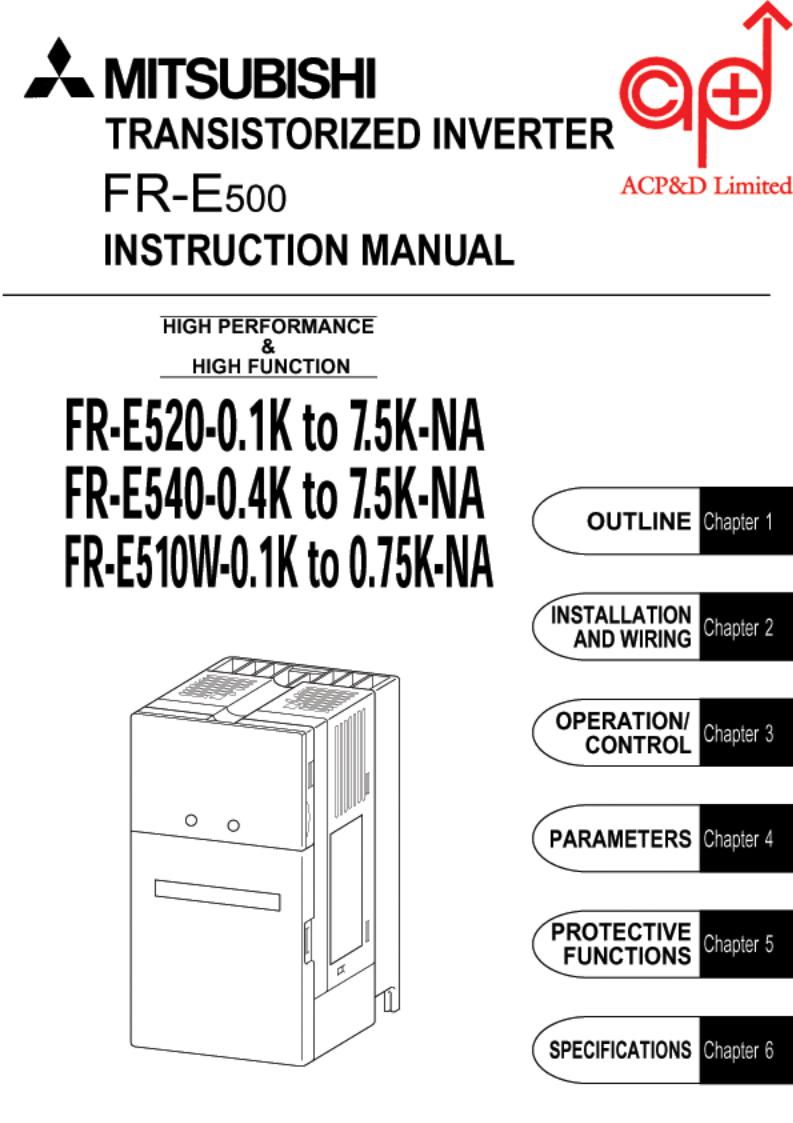

Thank you for choosing the Mitsubishi Transistorized inverter.
This instruction manual gives handling information and precautions for use of this equipment.
Incorrect handling might cause an unexpected fault. Before using the inverter, please read this manual carefully to use the equipment to its optimum.
Please forward this manual to the end user.
This instruction manual uses the International System of Units (SI). The measuring units in the yard and pound system are indicated in parentheses as reference values.
This section is specifically about safety matters
Do not attempt to install, operate, maintain or inspect the inverter until you have read through this instruction manual and appended documents carefully and can use the equipment correctly.
Do not use the inverter until you have a full knowledge of the equipment, safety information and instructions.
In this manual, the safety instruction levels are classified into "WARNING" and "CAUTION".

 WARNING
WARNING

 CAUTION
CAUTION
Assumes that incorrect handling may cause hazardous conditions, resulting in death or severe injury.
Assumes that incorrect handling may cause hazardous conditions, resulting in medium or slight injury, or may cause physical damage only.
Note that even the CAUTION level may lead to a serious consequence according to conditions. Please follow the instructions of both levels because they are important to personnel safety.
A - 1

SAFETY INSTRUCTIONS
1. Electric Shock Prevention
 WARNING
WARNING
!While power is on or when the inverter is running, do not open the front cover. You may get an electric shock.
!Do not run the inverter with the front cover removed. Otherwise, you may access the exposed high-voltage terminals or the charging part of the circuitry and get an electric shock.
!If power is off, do not remove the front cover except for wiring or periodic inspection. You may access the charged inverter circuits and get an electric shock.
!Before starting wiring or inspection, switch power off, wait for more than 10 minutes, and check for residual voltage with a meter (refer to chapter 2 for further details) etc.
!Earth the inverter.
!Any person who is involved in the wiring or inspection of this equipment should be fully competent to do the work.
!Always install the inverter before wiring. Otherwise, you may get an electric shock or be injured.
!Operate the switches and potentiometers with dry hands to prevent an electric shock.
!Do not subject the cables to scratches, excessive stress, heavy loads or pinching. Otherwise, you may get an electric shock.
!Do not change the cooling fan while power is on.
It is dangerous to change the cooling fan while power is on.
2.Fire Prevention
 CAUTION
CAUTION
!Mount the inverter and brake resistor on an incombustible surface. Installing the inverter directly on or near a combustible surface could lead to a fire.
!If the inverter has become faulty, switch off the inverter power. A continuous flow of large current could cause a fire.
!When a brake resistor is used, use an alarm signal to switch power off. Otherwise, the brake resistor will overheat abnormally due a brake transistor or other fault, resulting in a fire.
!Do not connect a resistor directly to the DC terminals P(+ ), N(− ). This could cause a fire.
A - 2
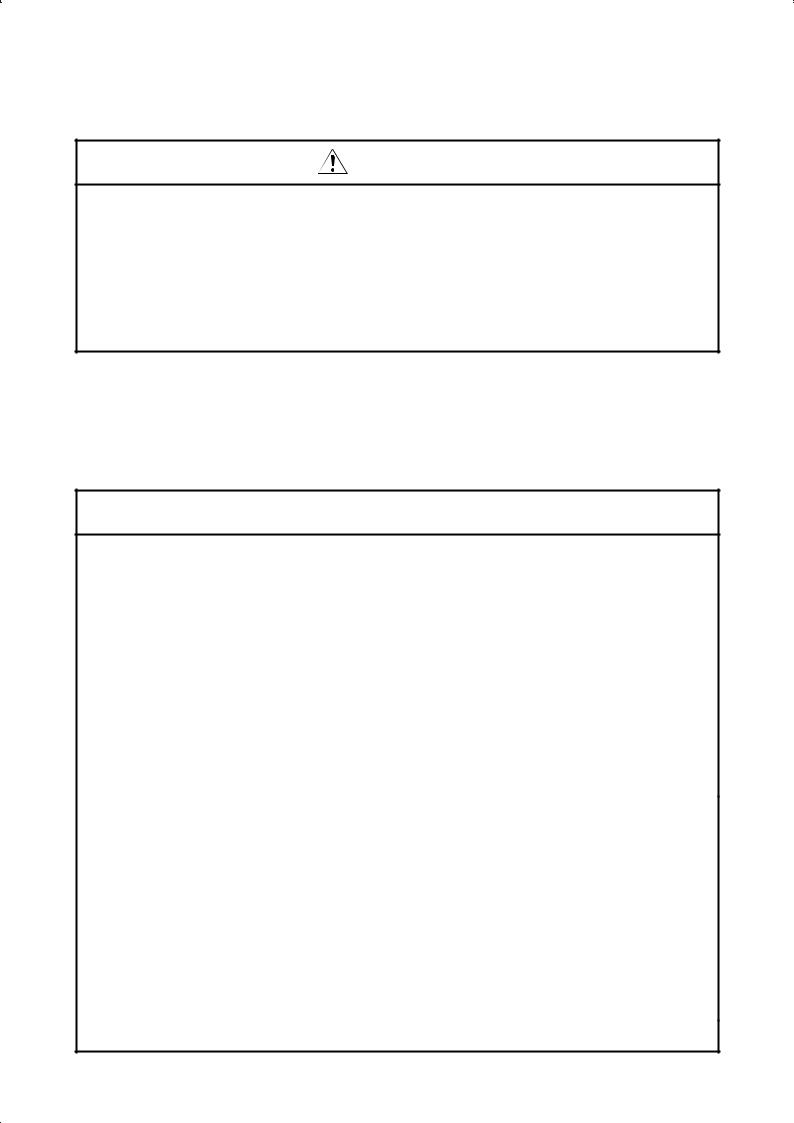
3. Injury Prevention
CAUTION
!Apply only the voltage specified in the instruction manual to each terminal to prevent damage etc.
!Ensure that the cables are connected to the correct terminals. Otherwise, damage etc. may occur.
!Always make sure that polarity is correct to prevent damage etc.
!While power is on and for some time after power-off, do not touch the inverter or brake resistor as they are hot and you may get burnt.
4.Additional instructions
Also note the following points to prevent an accidental failure, injury, electric shock, etc.
(1) Transportation and installation
 CAUTION
CAUTION
!When carrying products, use correct lifting gear to prevent injury.
!Do not stack the inverter boxes higher than the number recommended.
!Ensure that installation position and material can withstand the weight of the inverter. Install according to the information in the Instruction Manual.
!Do not operate if the inverter is damaged or has parts missing.
!Do not hold the inverter by the front cover or operation panel; it may fall off.
!Do not stand or rest heavy objects on the inverter.
!Check the inverter mounting orientation is correct.
!Prevent screws, wire fragments or other conductive bodies or oil or other flammable substance from entering the inverter.
!Do not drop the inverter, or subject it to impact.
!Use the inverter under the following environmental conditions:
|
Ambient |
Constant torque : -10° C to +50° C (14° F to 122 ° F) |
|
|
temperature |
(non-freezing) |
|
|
Ambient humidity |
90%RH or less (non-condensing) |
|
Environment |
Storage |
-20° C to +65° C * (-4° F to 149 ° F) |
|
temperature |
|||
|
|||
Ambience |
Indoors (free from corrosive gas, flammable gas, oil mist, dust |
||
and dirt) |
|||
|
|||
|
Maximum 1000m (3280.80 feet) above sea level for standard |
||
|
|
||
|
Altitude, vibration |
operation. After that derate by 3% for every extra 500m |
|
|
|
(1640.40 feet) up to 2500m (8202.00 feet) (91%). |
|
|
|
5.9 m/s2 or less (conforming to JIS C 0911) |
*Temperatures applicable for a short time, e.g. in transit.
A - 3
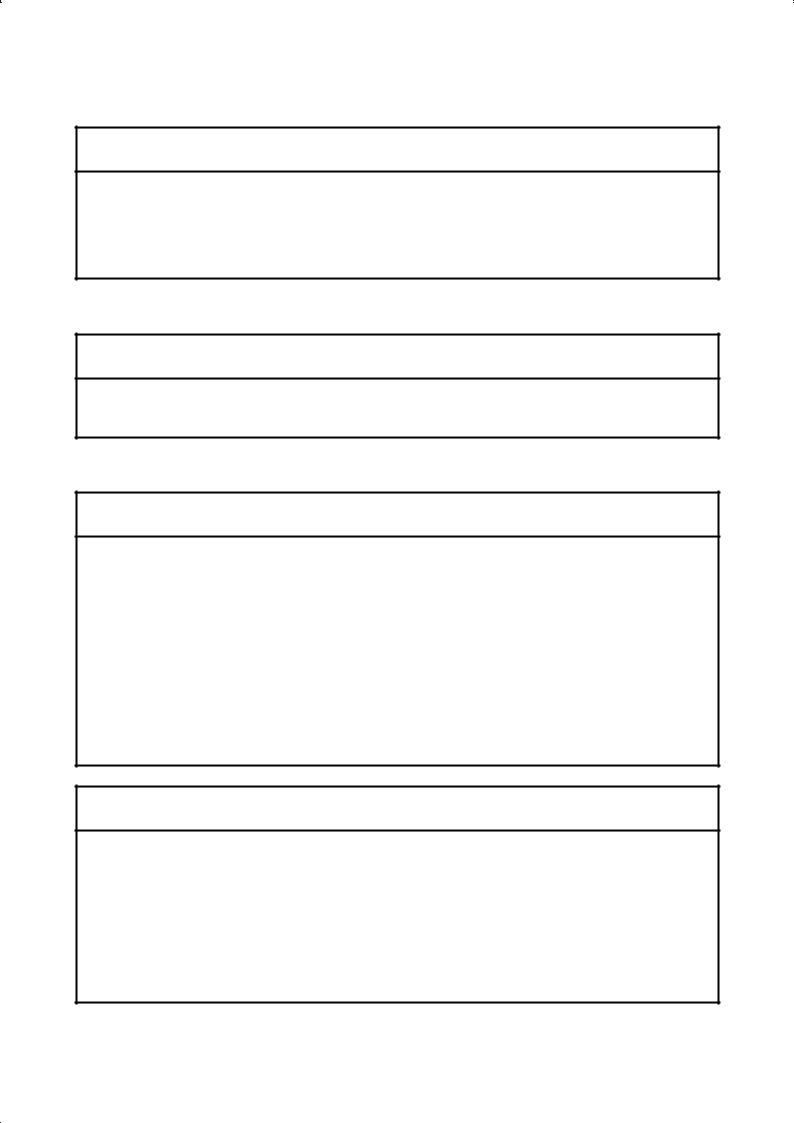
(2) Wiring
 CAUTION
CAUTION
!Do not fit capacitive equipment such as a power factor correction capacitor, radio noise filter or surge suppressor to the output of the inverter.
!The connection orientation of the output cables U, V, W to the motor will affect the direction of rotation of the motor.
(3) Trial run
 CAUTION
CAUTION
!Check all parameters, and ensure that the machine will not be damaged by a sudden start-up.
(4) Operation
 WARNING
WARNING
!When you have chosen the retry function, stay away from the equipment as it will restart suddenly after an alarm stop.
!The [STOP] key is valid only when the appropriate function setting has been made. Prepare an emergency stop switch separately.
!Make sure that the start signal is off before resetting the inverter alarm. A failure to do so may restart the motor suddenly.
!The load used should be a three-phase induction motor only. Connection of any other electrical equipment to the inverter output may damage the equipment.
!Do not modify the equipment.
 CAUTION
CAUTION
!The electronic overcurrent protection does not guarantee protection of the motor from overheating.
!Do not use a magnetic contactor on the inverter input for frequent starting/stopping of the inverter.
!Use a noise filter to reduce the effect of electromagnetic interference. Otherwise nearby electronic equipment may be affected.
!Take measures to suppress harmonics. Otherwise power harmonics from the inverter may heat/damage the power capacitor and generator.
A - 4
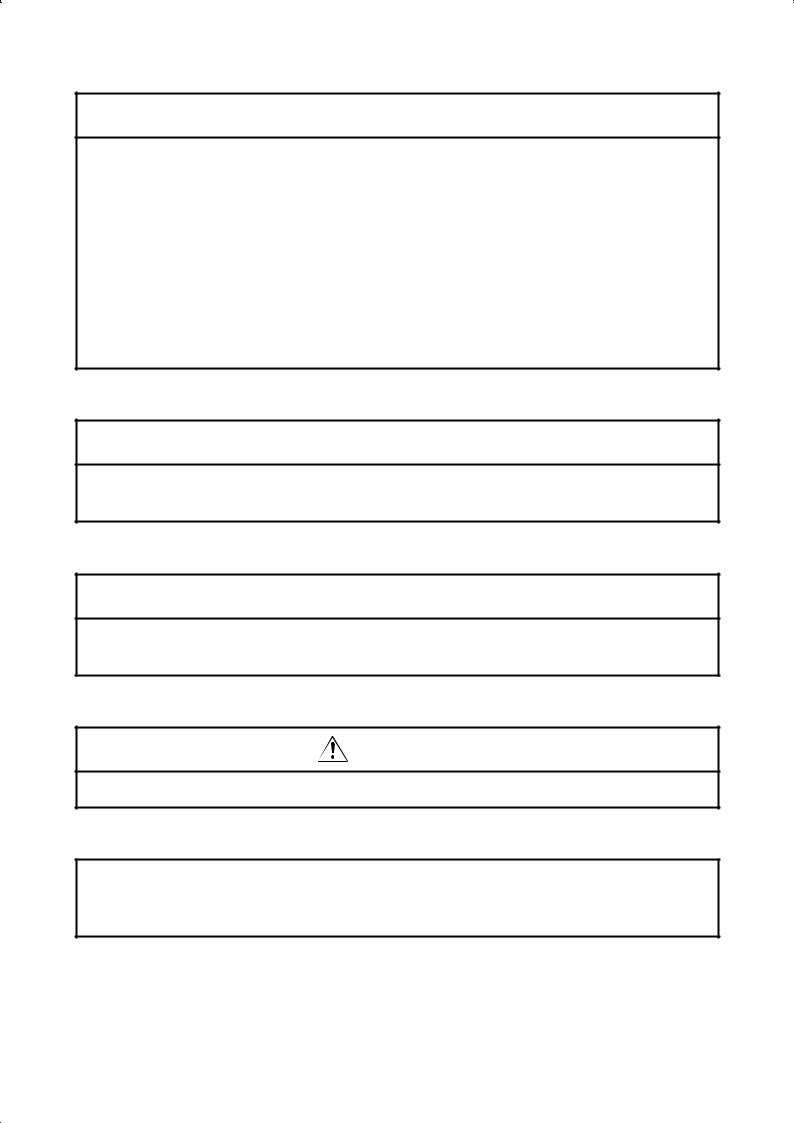
 CAUTION
CAUTION
!When a 400V class motor is inverter-driven, it should be insulation-enhanced or surge voltages suppressed. Surge voltages attributale to the wiring constants may occur at the motor terminals, deteriorating the insulation of the motor.
!When parameter clear or all clear is performed, each parameter returns to the factory setting. Re-set the required parameters before starting operation.
!The inverter can be easily set for high-speed operation. Before changing its setting, fully examine the performances of the motor and machine.
!In addition to the inverter's holding function, install a holding device to ensure safety.
!Before running an inverter which had been stored for a long period, always perform inspection and test operation.
(5) Emergency stop
 CAUTION
CAUTION
!Provide a safety backup such as an emergency brake which will prevent the machine and equipment from hazardous conditions if the inverter fails.
(6) Maintenance, inspection and parts replacement
 CAUTION
CAUTION
!Do not carry out a megger (insulation resistance) test on the control circuit of the inverter.
(7) Disposing of the inverter
CAUTION
! Treat as industrial waste.
(8) General instructions
Many of the diagrams and drawings in this instruction manual show the inverter without a cover, or partially open. Never operate the inverter like this. Always replace the cover and follow this instruction manual when operating the inverter.
A - 5
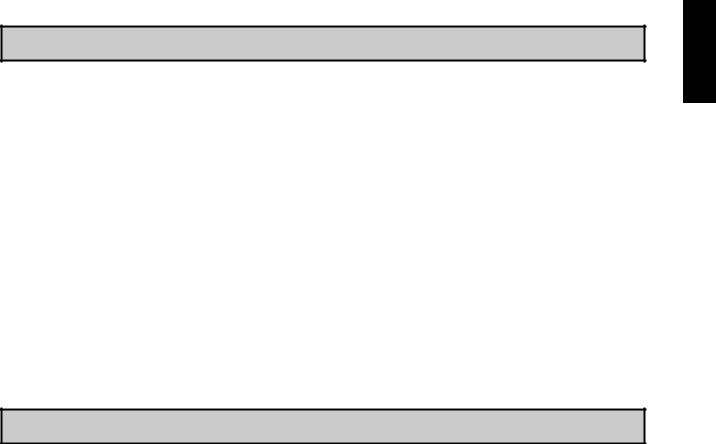
CONTENTS
1 OUTLINE |
1 |
1.1 Pre-Operation Information .......................................................................................... |
1 |
1.1.1 Precautions for operation ..................................................................................... |
1 |
1.2 Basic Configuration..................................................................................................... |
3 |
1.2.1 Basic configuration ............................................................................................... |
3 |
1.3 Structure ..................................................................................................................... |
4 |
1.3.1 Appearance and structure .................................................................................... |
4 |
1.3.2 Removal and reinstallation of the front cover ....................................................... |
5 |
1.3.3 Removal and reinstallation of the wiring cover ..................................................... |
7 |
1.3.4 Removal and reinstallation of the accessory cover .............................................. |
8 |
1.3.5 Reinstallation and removal of the control panel.................................................... |
9 |
1.3.6 Removal of the control panel (FR-PA02-02) front cover ..................................... |
10 |
1.3.7 Exploded view .................................................................................................... |
11 |
2 INSTALLATION AND WIRING |
12 |
2.1 Installation................................................................................................................. |
12 |
2.1.1 Instructions for installation.................................................................................. |
12 |
2.2 Wiring........................................................................................................................ |
14 |
2.2.1 Terminal connection diagram ............................................................................. |
14 |
2.2.2 Wiring of the main circuit.................................................................................... |
18 |
2.2.3 Wiring of the control circuit ................................................................................. |
22 |
2.2.4 Connection to the PU connector ........................................................................ |
27 |
2.2.5 Connection of stand-alone option units .............................................................. |
30 |
2.2.6 Design information ............................................................................................. |
33 |
2.3 Other Wiring.............................................................................................................. |
34 |
2.3.1 Power supply harmonics .................................................................................... |
34 |
2.3.2 Inverter-generated noise and reduction techniques ........................................... |
35 |
2.3.3 Leakage currents and countermeasures............................................................ |
39 |
2.3.4 Inverter-driven 400V class motor........................................................................ |
40 |
2.3.5 Peripheral devices.............................................................................................. |
41 |
2.3.6 Instructions for compliance with U.S and Canadian Electrical Codes ................ |
45 |
2.3.7 Instructions for compliance with the European standards .................................. |
46 |
Contents
I
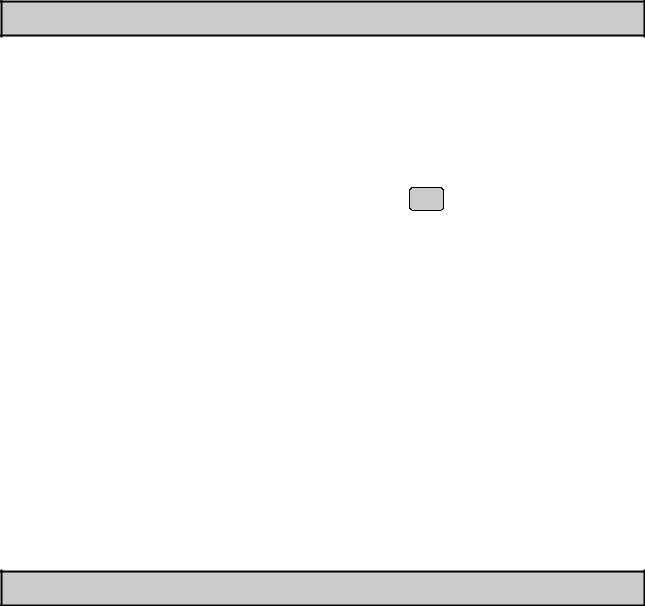
3 OPERATION/CONTROL |
48 |
3.1 Pre-Operation Information ........................................................................................ |
48 |
3.1.1 Types of operation modes.................................................................................. |
48 |
3.1.2 Power on ............................................................................................................ |
50 |
3.2 About the Control Panel............................................................................................ |
51 |
3.2.1 Names and functions of the control panel (FR-PA02-02).................................... |
51 |
3.2.2 Control panel mode is changed by pressing the MODE key ................................. |
52 |
3.2.3 Monitoring........................................................................................................... |
52 |
3.2.4 Frequency setting............................................................................................... |
53 |
3.2.5 Parameter setting method .................................................................................. |
53 |
3.2.6 Operation mode.................................................................................................. |
55 |
3.2.7 Help mode .......................................................................................................... |
55 |
3.3 Operation .................................................................................................................. |
58 |
3.3.1 Pre-operation checks ......................................................................................... |
58 |
3.3.2 External operation mode (Operation using the external |
|
frequency setting potentiometer and external start signal)................................. |
59 |
3.3.3 PU operation mode (Operation using the control panel) .................................... |
60 |
3.3.4 Combined operation mode 1 |
|
(Operation using both external start signal and control panel)........................... |
61 |
3.3.5 Combined operation mode 2 .............................................................................. |
62 |
4 PARAMETERS |
63 |
4.1 Parameter List........................................................................................................... |
63 |
4.1.1 Parameter list ..................................................................................................... |
63 |
4.1.2 List of parameters classified by purpose of use ................................................. |
69 |
4.1.3 Parameters recommended to be set by the user ............................................... |
71 |
4.2 Parameter Function Details ...................................................................................... |
72 |
4.2.1 Torque boost (Pr. 0, Pr. 46)................................................................................ |
72 |
4.2.2 Output frequency range (Pr. 1, Pr. 2, Pr. 18)...................................................... |
73 |
4.2.3 Base frequency, base frequency voltage (Pr. 3, Pr. 19, Pr. 47) ......................... |
74 |
4.2.4 Multi-speed operation (Pr. 4, Pr. 5, Pr. 6, Pr. 24 to Pr. 27, Pr. 232 to Pr. 239) .75 |
|
4.2.5 Acceleration/deceleration time (Pr. 7, Pr. 8, Pr. 20, Pr. 21, Pr. 44, Pr. 45) ....... |
76 |
4.2.6 Electronic overcurrent protection (Pr. 9, Pr. 48) ................................................. |
78 |
4.2.7 DC injection brake (Pr. 10 to Pr. 12)................................................................... |
79 |
II |
|

4.2.8 Starting frequency (Pr. 13) ................................................................................. |
80 |
4.2.9 Load pattern selection (Pr. 14) ........................................................................... |
81 |
4.2.10 Jog operation (Pr. 15, Pr. 16) ........................................................................... |
82 |
4.2.11 Stall prevention (Pr. 22, Pr. 23, Pr. 66)............................................................. |
83 |
4.2.12 Acceleration/deceleration pattern (Pr. 29)........................................................ |
85 |
4.2.13 Regenerative brake duty (Pr. 30, Pr. 70).......................................................... |
86 |
4.2.14 Frequency jump (Pr. 31 to Pr. 36) .................................................................... |
87 |
4.2.15 Speed display (Pr. 37)...................................................................................... |
88 |
4.2.16 Frequency at 5V (10V) input (Pr. 38)................................................................ |
89 |
4.2.17 Frequency at 20mA input (Pr. 39) .................................................................... |
89 |
4.2.18 Up-to-frequency sensitivity (Pr. 41) .................................................................. |
90 |
4.2.19 Output frequency detection (Pr. 42, Pr. 43)...................................................... |
90 |
4.2.20 Monitor display (Pr. 52, Pr. 54, Pr. 158) ........................................................... |
92 |
4.2.21 Monitoring reference (Pr. 55, Pr. 56)................................................................ |
94 |
4.2.22 Automatic restart after instantaneous power failure (Pr. 57, Pr. 58)................. |
95 |
4.2.23 Remote setting function selection (Pr. 59)........................................................ |
97 |
4.2.24 Shortest acceleration/deceleration mode (Pr. 60 to Pr. 63).............................. |
99 |
4.2.25 Retry function (Pr. 65, Pr. 67 to Pr. 69) .......................................................... |
101 |
4.2.26 Applied motor (Pr. 71) .................................................................................... |
103 |
4.2.27 PWM carrier frequency (Pr. 72, Pr. 240) ........................................................ |
104 |
4.2.28 Voltage input (Pr. 73) ..................................................................................... |
105 |
4.2.29 Input filter time constant (Pr. 74) .................................................................... |
106 |
4.2.30 Reset selection/disconnected PU detection/PU stop selection (Pr. 75) ......... |
106 |
4.2.31 Parameter write inhibit selection (Pr. 77)........................................................ |
108 |
4.2.32 Reverse rotation prevention selection (Pr. 78) ............................................... |
109 |
4.2.33 Operation mode selection (Pr. 79) ................................................................. |
110 |
4.2.34 General-purpose magnetic flux vector control selection (Pr. 80)......................... |
113 |
4.2.35 Offline auto tuning function (Pr. 82 to Pr. 84, Pr. 90, Pr. 96).......................... |
115 |
4.2.36 Computer link operation (Pr. 117 to Pr. 124, Pr. 342) .................................... |
121 |
4.2.37 PID control (Pr. 128 to Pr. 134) ...................................................................... |
134 |
4.2.38 Output current detection function (Pr. 150, Pr.151)........................................ |
142 |
4.2.39 Zero current detection (Pr. 152, Pr.153)......................................................... |
143 |
4.2.40 Stall prevention function and current limit function (Pr. 156) .......................... |
144 |
4.2.41 User group selection (Pr. 160, Pr. 173 to Pr. 176) ......................................... |
146 |
4.2.42 Actual operation hour meter clear (Pr. 171) ................................................... |
148 |
III |
|
Contents

4.2.43 Input terminal function selection (Pr. 180 to Pr. 183) ..................................... |
148 |
4.2.44 Output terminal function selection (Pr. 190 to Pr. 192)................................... |
150 |
4.2.45 Cooling fan operation selection (Pr. 244) ....................................................... |
151 |
4.2.46 Slip compensation (Pr. 245 to Pr. 247) .......................................................... |
152 |
4.2.47 Ground fault detection at start (Pr. 249) |
|
(400V class does not have this function) ........................................................ |
153 |
4.2.48 Stop selection (Pr. 250).................................................................................. |
154 |
4.2.49 Output phase failure protection selection (Pr. 251) ........................................ |
155 |
4.2.50 Meter (frequency meter) calibration (Pr. 900) (200V class, 100V class) ....... |
156 |
4.2.51 Meter (frequency meter) calibration (Pr. 901) (400V class)............................ |
158 |
4.2.52 Biases and gains of the frequency setting voltage (current) |
|
(Pr. 902 to Pr. 905)........................................................................................... |
160 |
5 PROTECTIVE FUNCTIONS |
166 |
5.1 Errors (Alarms)........................................................................................................ |
166 |
5.1.1 Error (alarm) definitions.................................................................................... |
166 |
5.1.2 To know the operating status at the occurrence of alarm................................. |
174 |
5.1.3 Correspondence between digital and actual characters................................... |
174 |
5.1.4 Resetting the inverter ....................................................................................... |
174 |
5.2 Troubleshooting ...................................................................................................... |
175 |
5.2.1 Motor remains stopped..................................................................................... |
175 |
5.2.2 Motor rotates in opposite direction ................................................................... |
175 |
5.2.3 Speed greatly differs from the setting............................................................... |
176 |
5.2.4 Acceleration/deceleration is not smooth........................................................... |
176 |
5.2.5 Motor current is large........................................................................................ |
176 |
5.2.6 Speed does not increase.................................................................................. |
176 |
5.2.7 Speed varies during operation.......................................................................... |
176 |
5.2.8 Operation mode is not changed properly ......................................................... |
177 |
5.2.9 Control panel display is not operating .............................................................. |
177 |
5.2.10 POWER lamp is not lit.................................................................................... |
177 |
5.2.11 Parameter write cannot be performed............................................................ |
177 |
5.3 Precautions for Maintenance and Inspection.......................................................... |
178 |
5.3.1 Precautions for maintenance and inspection ................................................... |
178 |
5.3.2 Check items...................................................................................................... |
178 |
5.3.3 Periodic inspection ........................................................................................... |
178 |
IV |
|

5.3.4 Insulation resistance test using megger ........................................................... |
179 |
5.3.5 Pressure test .................................................................................................... |
179 |
5.3.6 Daily and Periodic Inspection ........................................................................... |
180 |
5.3.7 Replacement of parts ....................................................................................... |
183 |
5.3.8 Measurement of main circuit voltages, currents and powers............................ |
188 |
6 SPECIFICATIONS |
191 |
6.1 Standard Specifications .......................................................................................... |
191 |
6.1.1 Model specifications ......................................................................................... |
191 |
6.1.2 Common specifications .................................................................................... |
194 |
6.1.3 Outline drawings............................................................................................... |
196 |
APPENDIX |
202 |
Appendix 1 Data Code List ........................................................................................... |
202 |
Contents
V
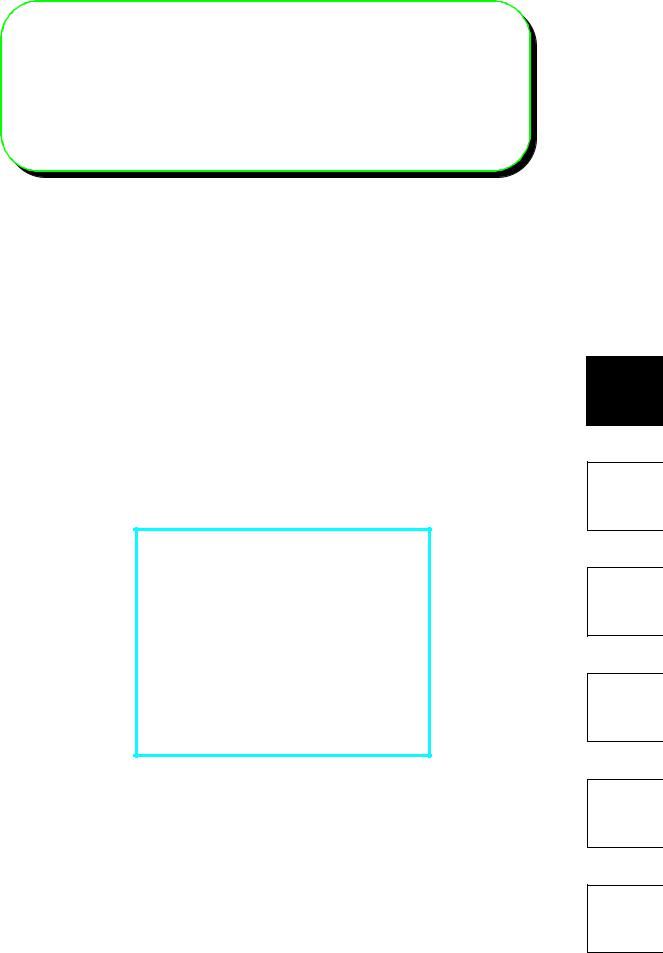
C CHAPTERA P T E R 1 1
O OUTLINET L I N E
This chapter gives information on the basic "outline" of this product.
Always read the instructions before using the equipment.
1.1 |
Pre-Operation Information .......................................... |
1 |
1.2 |
Basic Configuration..................................................... |
3 |
1.3 |
Structure ..................................................................... |
4 |
<Abbreviations>
!PU
Control panel and parameter unit (FR-PU04)
!Inverter
Mitsubishi transistorized inverter FR-E500 series
!Pr.
Parameter number
Chapter 1
Chapter 2
Chapter 3
Chapter 4
Chapter 5
Chapter 6

1.1 Pre-Operation Information
OUTLINE
1.1.1 Precautions for operation
This manual is written for the FR-E500 series transistorized inverters.
Incorrect handling may cause the inverter to operate incorrectly, causing its life to be reduced considerably, or at the worst, the inverter to be damaged. Handle the inverter properly in accordance with the information in each section as well as the precautions and instructions of this manual to use it correctly.
For handling information on the parameter unit (FR-PU04), stand-alone options, etc., refer to the corresponding manuals.
(1) Unpacking and product check
Unpack the inverter and check the capacity plate on the front cover and the rating plate on the inverter side face to ensure that the product agrees with your order and the inverter is intact.
1) Inverter type
Capacity plate |
|
|
|
|
Rating plate |
|
|
|
|
||||||||
|
|
|
|
|
|
|
|
|
|
|
|
|
|
|
|
|
|
|
|
|
|
|
|
|
|
|
Rating plate |
|
MITSUBISHI |
INVERTER |
|
|
|||
|
|
Capacity plate |
|
|
|
|
|
|
MODEL FR-E520-0.1K-NA |
|
Inverter type |
||||||
|
|
|
|
|
|
|
|
|
|||||||||
|
|
|
|
|
|
|
Input rating |
||||||||||
FR-E520-0.1K-NA/ |
|
|
|
|
|
|
|
INPUT : XXXXX |
|
|
|
|
|||||
|
|
|
|
|
|
|
|
|
|
|
|
|
|||||
|
|
|
|
|
Output rating |
|
|
|
|
|
|
|
|
||||
|
|
|
|
|
|
|
OUTPUT : XXXXX |
|
|
|
|
||||||
|
|
|
|
|
|
|
|
|
|
|
|
|
|||||
|
|
|
|
|
|
|
|
|
Serial number |
|
|
|
|
|
|
|
|
|
|
|
|
|
|
|
|
|
|
|
|
|
|
|
|
|
|
|
|
|
|
|
|
|
|
|
|
|
SERIAL : |
|
|
|
|
|
|
Inverter type |
Serial number |
|
|
|
|
|
PASSED |
|
|
||||||||
|
|
|
|
|
|
|
|
|
|
|
|||||||
|
|
|
|
|
|
|
|
|
|
|
|
||||||
|
|
|
|
|
|
|
|
|
|
|
|||||||
|
|
|
|
|
|
|
|
|
|
|
|
|
|
|
|
|
|
" Inverter type |
|
|
|
|
||
FR - E520 - |
0.1 |
K - NA |
||||
|
|
|
|
|
|
|
|
|
|
|
|
|
|
Symbol |
Voltage Class |
Represents the |
|
|
||
|
Three-phase |
|
|
|||
E520 |
inverter capacity |
|
|
|||
200V class |
|
|
||||
|
"kW ". |
|
|
|||
|
Three-phase |
|
|
|||
E540 |
|
|
|
|
||
400V class |
|
|
|
|
||
|
|
|
|
|
||
E510W |
Single-phase |
|
|
|
|
|
100V class |
|
|
|
|
||
|
|
|
|
|
||
|
|
|
|
|
|
|
2) Accessory
Instruction manual
If you have found any discrepancy, damage, etc., please contact your sales representative.
1

OUTLINE
(2) Preparation of instruments and parts required for operation
Instruments and parts to be prepared depend on how the inverter is operated. Prepare equipment and parts as necessary. (Refer to page 48.)
(3) Installation
To operate the inverter with high performance for a long time, install the inverter in a proper place, in the correct direction, with proper clearances. (Refer to page 12.)
(4) Wiring
Connect the power supply, motor and operation signals (control signals) to the terminal block. Note that incorrect connection may damage the inverter and peripheral devices. (See page 14.)
1
2
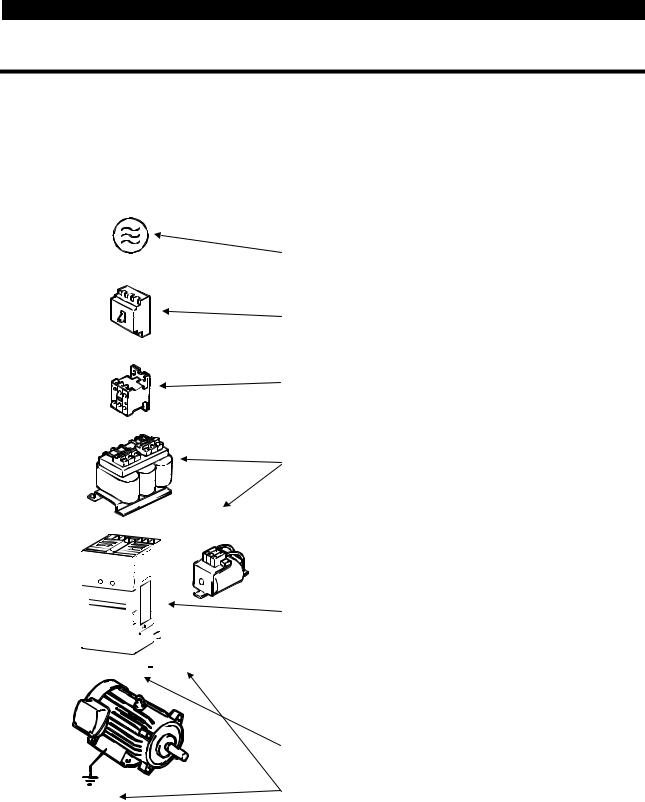
1.2 Basic Configuration
OUTLINE
1.2.1 Basic configuration
The following devices are required to operate the inverter. Proper peripheral devices must be selected and correct connections made to ensure proper operation. Incorrect system configuration and connections can cause the inverter to operate improperly, its life to be reduced considerably, and in the worst case, the inverter to be damaged. Please handle the inverter properly in accordance with the information in each section as well as the precautions and instructions of this manual. (For connections of the peripheral devices, refer to the corresponding manuals.)
|
|
|
|
|
|
|
|
|
|
|
|
|
Name |
Description |
|
|
|
|
|
|
|
|
|
|
|
|
|
Power |
Use the power supply within the |
|
|
|
|
|
|
|
|
|
|
|
|
|
permissible power supply specifications |
|
|
|
|
|
|
|
|
|
|
|
|
|
|
supply |
|
|
|
|
|
|
|
|
|
|
|
|
|
|
||
|
|
|
|
|
|
|
|
|
|
|
|
|
of the inverter. (Refer to page 191.) |
|
|
|
|
|
|
|
|
|
|
|
|
|
|
|
|
|
|
|
|
|
|
|
|
|
|
|
|
|
|
|
(NFB) |
|
|
|
|
|
|
|
|
Earth leakage |
The breaker should be selected with |
||||
or |
|
|
|
|
|
|
|
|
circuit breaker |
care since a large inrush current flows |
||||
(ELB) |
|
|
|
|
|
|
|
|
or no-fuse |
in the inverter at power on. (Refer to |
||||
|
|
|
|
|
|
|
|
|
|
|
|
|
breaker |
page 41.) |
|
|
|
|
|
|
|
|
|
|
|
|
|
||
|
|
|
|
|
|
|
|
|
|
|
|
|
Magnetic |
Do not use this magnetic contactor to |
|
|
|
|
|
|
|
|
|
|
|
|
|
||
|
|
|
|
|
|
|
|
|
|
|
|
|
start or stop the inverter. It might reduce |
|
|
|
|
|
|
|
|
|
|
|
|
|
|
contactor |
|
(MC) |
|
|
|
|
|
|
|
|
the inverter life. (Refer to page 41.) |
|||||
|
|
|
|
|
|
|
|
|
||||||
|
|
|
|
|
|
|
|
|
|
|
|
|
|
The reactors must be used when the |
|
|
|
|
|
|
|
|
|
|
|
|
|
|
|
|
|
|
|
|
|
|
|
|
|
|
|
|
|
power factor is to be improved or the |
|
|
|
|
|
|
|
|
|
|
|
|
|
|
|
AC reactor |
|
|
|
|
|
|
|
|
Reactors |
inverter is installed near a large power |
||||
|
|
|
|
|
|
|
|
supply system (1000KVA or more and |
||||||
(FR-BAL) |
|
|
|
|
|
|
|
|
|
|||||
|
|
|
|
|
|
|
|
|
wiring distance within 10m (32.81 feet)). |
|||||
|
|
|
|
|
|
|
|
|
|
|
|
|
|
|
|
|
|
|
|
|
|
|
|
|
|
DC reactor |
|
Make selection carefully. |
|
|
|
|
|
|
|
|
|
|
|
|
|
|
||
|
|
|
|
|
|
• The inverter life is influenced by |
||||||||
|
|
|
|
|
|
|
||||||||
|
|
|
|
|
|
|
|
|
|
|
(FR-BEL) |
|
ambient temperature. The ambient |
|
|
|
|
|
|
|
|
|
|
|
|
|
|||
|
|
|
|
|
|
|
|
|
|
|
|
|
|
|
|
|
|
|
|
|
|
|
|
|
|
|
|
|
temperature should be as low as |
|
|
|
|
|
|
|
|
|
|
|
|
|
|
possible within the permissible range. |
|
|
|
|
|
|
|
|
|
|
|
|
|
|
|
|
|
|
|
|
|
|
|
|
|
|
|
|
|
|
|
|
|
|
|
|
|
|
|
|
|
|
|
|
This must be noted especially when |
|
|
|
|
|
|
|
|
|
|
|
|
|
|
|
|
|
|
|
|
|
|
|
|
|
|
|
|
|
|
|
|
|
|
|
|
|
|
|
|
|
|
|
Inverter |
the inverter is installed in an enclosure. |
|
|
|
|
|
|
|
|
|
|
|
|
|
||
|
|
|
|
|
|
|
|
|
|
|
|
|
||
|
|
|
|
|
|
|
|
|
|
|
|
|
(Refer to page 12.) |
|
|
|
|
|
|
|
|
|
|
|
|
|
|
||
|
|
|
|
|
|
|
|
|
|
|
|
|
|
|
|
|
|
|
|
|
|
|
|
|
|
|
|
|
|
|
|
|
|
|
|
|
|
|
|
|
Ground |
|
• Wrong wiring might lead to inverter |
|
|
|
|
|
|
|
|
|
|
|
|
|
|||
|
|
|
|
|
|
|
|
|
|
|
|
damage. The control signal lines should |
||
|
|
|
|
|
|
|
|
|
|
|
|
|||
|
|
|
|
|
|
|
|
|
|
|
|
|
|
be kept away from the main circuit to |
|
|
|
|
|
|
|
|
|
|
|
|
|
|
|
|
|
|
|
|
|
|
|
|
|
|
|
|
|
protect them from noise. (Refer to page |
|
|
|
|
|
|
|
|
|
|
|
|
|
|
14.) |
|
|
|
|
|
|
|
|
|
|
|
|
|
|
|
|
|
|
|
|
|
|
|
|
|
|
|
|
Devices |
Do not connect a power capacitor, |
|
|
|
|
|
|
|
|
|
|
|
|
|
connected |
surge suppressor or radio noise |
|
|
|
|
|
|
|
|
|
|
|
|
|
to the output |
filter to the output side. |
|
|
|
|
|
|
|
|
|
|
|
|
|
|
|
Ground |
|
|
|
|
|
|
|
|
|
To prevent an electric shock, always |
||||
|
|
|
|
|
|
|
|
|
ground the motor and inverter. |
|||||
|
|
|
|
|
|
|
|
|
|
|
|
|
|
|
|
|
|
|
|
|
|
|
|
|
|
|
|
|
The ground wiring from the power line |
|
|
|
|
|
|
|
|
|
|
|
|
|
Ground |
of the inverter as an induction noise |
|
|
|
|
|
|
|
|
|
|
|
|
|
reduction technique is recommended to |
|
|
|
|
|
|
|
|
|
|
|
|
|
|
|
|
|
|
|
|
|
|
|
|
|
|
|
|
|
|
be run by returning it to the ground |
|
|
|
|
|
|
|
|
|
|
|
|
|
|
terminal of the inverter. (Refer to page |
|
|
|
|
|
|
|
|
|
|
|
|
|
|
38.) |
3
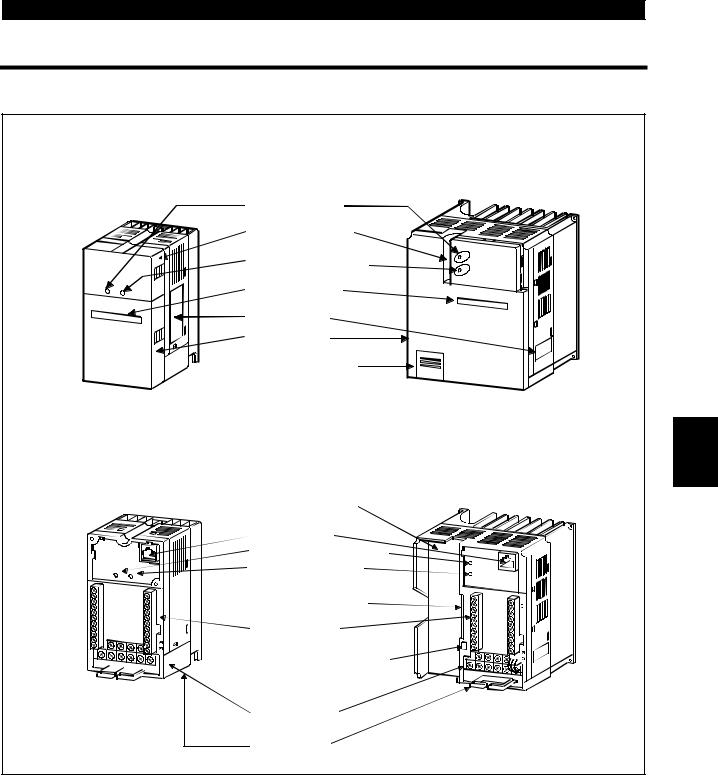
1.3 Structure
OUTLINE
1.3.1 Appearance and structure
(1) Front view |
|
(100V class, 200V class) |
(400V class) |
POWER lamp |
|
(yellow) |
|
Accessory cover |
|
ALARM lamp (red) |
|
Capacity plate |
|
Rating plate |
|
Front cover |
|
Wiring port cover |
|
for option |
|
(2) Without accessory cover and front cover |
1 |
|
|
(100V class, 200V class) |
(400V class) |
Inboard option |
|
mounting position |
|
PU conector* |
|
POWER lamp (yellow) |
|
ALARM lamp (red) |
|
Connector for connection |
|
of inboard option |
|
(400V class only) |
|
Control circuit |
|
terminal block |
|
Control logic changing |
|
connector |
|
(400V class only) |
|
Main circuit |
|
terminal block |
|
Wiring cover |
|
*Use the PU connector for the FR-PA02-02 or FR-PU04 option and RS-485 communication.
4

OUTLINE
1.3.2 Removal and reinstallation of the front cover
" Removal
(For the FR-E520-0.1K to 3.7K-NA, FR-E510W-0.1K to 0.75K-NA)
The front cover is secured by catches in positions A and B as shown below. Push either A or B in the direction of arrows, and using the other end as a support, pull the front cover toward you to remove.
1) |
2) |
3) |
A |
B |
|
(For the FR-E520-5.5K, 7.5K-NA)
The front cover is fixed with catches in positions A, B and C.
Push A and B in the directions of arrows at the same time and remove the cover using C as supporting points.
1) |
|
A |
B |
C |
C |
2) |
3) |
5
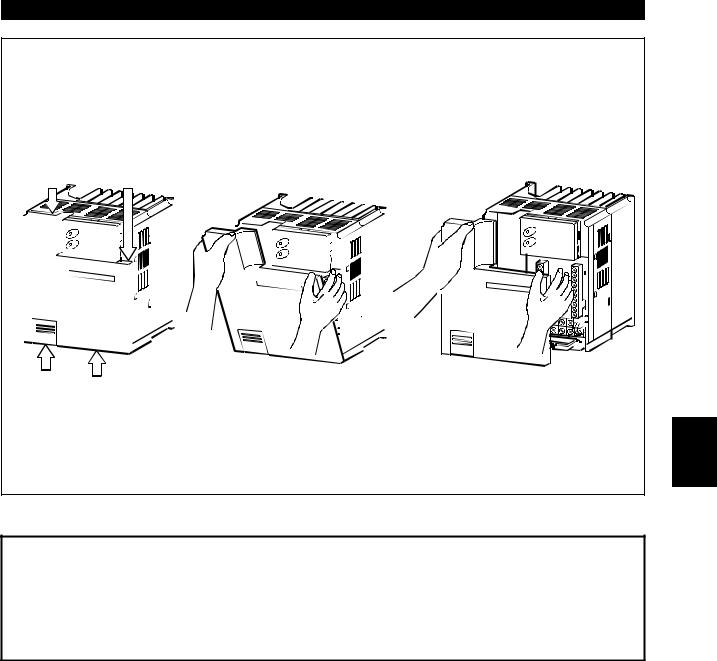
OUTLINE
(For the FR-E540-0.4K to 7.5K-NA)
The front cover is fixed with catches in positions A, B and C.
Push A and B in the directions of arrows at the same time and remove the cover using C as supporting points.
1) |
|
A |
|
|
B |
2) |
|
|
|
|
|
3) |
||||||||||||||||||||||||||||
|
|
|
|
|
|
|
|
|
|
|
|
|
|
|
|
|
|
|
|
|
|
|
|
|
|
|
|
|||||||||||||
|
|
|
|
|
|
|
|
|
|
|
|
|
|
|
|
|
|
|
|
|
|
|
|
|
|
|
|
|
|
|
|
|
|
|
|
|
|
|
|
|
|
|
|
|
|
|
|
|
|
|
|
|
|
|
|
|
|
|
|
|
|
|
|
|
|
|
|
|
|
|
|
|
|
|
|
|
|
|
|
|
|
|
|
|
|
|
|
|
|
|
|
|
|
|
|
|
|
|
|
|
|
|
|
|
|
|
|
|
|
|
|
|
|
|
|
|
|
|
|
|
|
|
|
|
|
|
|
|
|
|
|
|
|
|
|
|
|
|
|
|
|
|
|
|
|
|
|
|
|
|
|
|
|
|
|
|
|
|
|
|
|
|
|
|
|
|
|
|
|
|
|
|
|
|
|
|
|
|
|
|
|
|
|
|
|
|
|
|
|
|
|
|
|
|
|
|
|
|
|
|
|
|
|
|
|
|
|
|
|
|
|
|
|
|
|
|
|
|
|
|
|
|
|
|
|
|
|
|
|
|
|
|
|
|
|
|
|
|
|
|
|
|
|
|
|
|
|
|
|
|
|
|
|
|
|
|
|
|
|
|
|
|
|
|
|
|
|
|
|
|
|
|
|
|
|
|
|
|
|
|
|
|
|
|
|
|
|
|
|
|
|
|
|
|
|
|
|
|
|
|
|
|
|
|
|
|
|
|
|
|
|
|
|
|
|
|
|
|
|
|
|
|
|
|
|
|
|
|
|
|
|
|
|
|
|
|
|
|
|
|
|
|
|
|
|
|
|
|
|
|
|
|
|
|
|
|
|
|
|
|
|
|
|
|
|
|
|
|
|
|
|
|
|
|
|
|
|
|
|
|
|
|
|
|
|
|
|
|
|
|
|
|
|
|
|
|
|
|
|
|
|
|
|
|
|
|
|
|
|
|
|
|
|
|
|
|
|
|
|
|
|
|
|
|
|
|
|
|
|
|
|
|
|
|
|
|
|
|
|
|
|
|
|
|
|
|
|
|
|
|
|
|
|
|
|
|
|
|
|
|
|
|
|
|
|
|
|
|
|
|
|
|
|
|
|
|
|
|
|
|
|
|
|
|
|
|
|
|
|
|
|
C |
C |
|
|
|
|
" Reinstallation |
|
|
When reinstalling the front cover after wiring, fix the catches securely. |
1 |
|
With the front cover removed, do not switch power on. |
|
|
Note:1. Make sure that the front cover has been reinstalled securely.
2.The same serial number is printed on the capacity plate of the front cover and the rating plate of the inverter. Before reinstalling the front cover, check the serial numbers to ensure that the cover removed is reinstalled to the inverter from where it was removed.
6

OUTLINE
1.3.3 Removal and reinstallation of the wiring cover
" Removal
(For the FR-E520-0.1K to 7.5K-NA, FR-E510W-0.1K to 0.75K-NA)
The wiring cover is fixed by catches in positions 1) and 2).
Push either 1) or 2) in the direction of arrows and pull the wiring cover downward to remove.
1) |
|
|
|
|
|
|
|
|
|
|
|
|
|
|
|
|
|
|
|
|
|
2) |
|
|
|
|
|
|
|
|
|
|
|
|
|
|
|
|
|
|
|
|
|
|
|
|
|
|
|
|
|
|
|
|
|
||
|
|
|
|
|
|
|
|
|
|
|
|
|
|
|
|
|
|
|
|
|
|
|
|
|
|
|
||
|
|
|
|
|
|
|
|
|
|
|
|
|
|
|
|
|
|
|
|
|
|
|
|
|
|
|
||
|
|
|
|
|
|
|
|
|
|
|
|
|
|
|
|
|
|
|
|
|
|
|
|
|
|
|
||
|
|
|
|
|
|
|
|
|
|
|
|
|
|
|
|
|
|
|
|
|
|
|
|
|
|
|
||
|
|
|
|
|
|
|
|
|
|
|
|
|
|
|
|
|
|
|
|
|
|
|
|
|
|
|
||
|
|
|
|
|
|
|
|
|
|
|
|
|
|
|
|
|
|
|
|
|
|
|
|
|
|
|
||
|
|
|
|
|
|
|
|
|
|
|
|
|
|
|
|
|
|
|
|
|
|
|
|
|
|
|
||
|
|
|
|
|
|
|
|
|
|
|
|
|
|
|
|
|
|
|
|
|
|
|
|
|
|
|||
|
|
|
|
|
|
|
|
|
|
|
|
|
|
|
|
|
|
|
|
|
||||||||
|
|
|
|
|
|
|
|
|
|
|
|
|
|
|
|
|
|
|
|
|
|
|
|
|
|
|
|
|
|
|
|
|
|
|
|
|
|
|
|
|
|
|
|
|
|
|
|
|
|
|
|
|
|
|
|
|
|
|
|
|
|
|
|
|
|
|
|
|
|
|
|
|
|
|
|
|
|
|
|
|
|
|
|
|
|
|
|
|
|
|
|
|
|
|
|
|
|
|
|
|
|
|
|
|
|
|
|
|
|
|
|
|
|
|
|
Wiring hole
(For the FR-E540-0.4K to 7.5K-NA)
Remove the wiring cover by pulling it in the direction of arrow A.
A







 Wiring hole
Wiring hole
" Reinstallation
Pass the cables through the wiring hole and reinstall the cover in the original position.
7
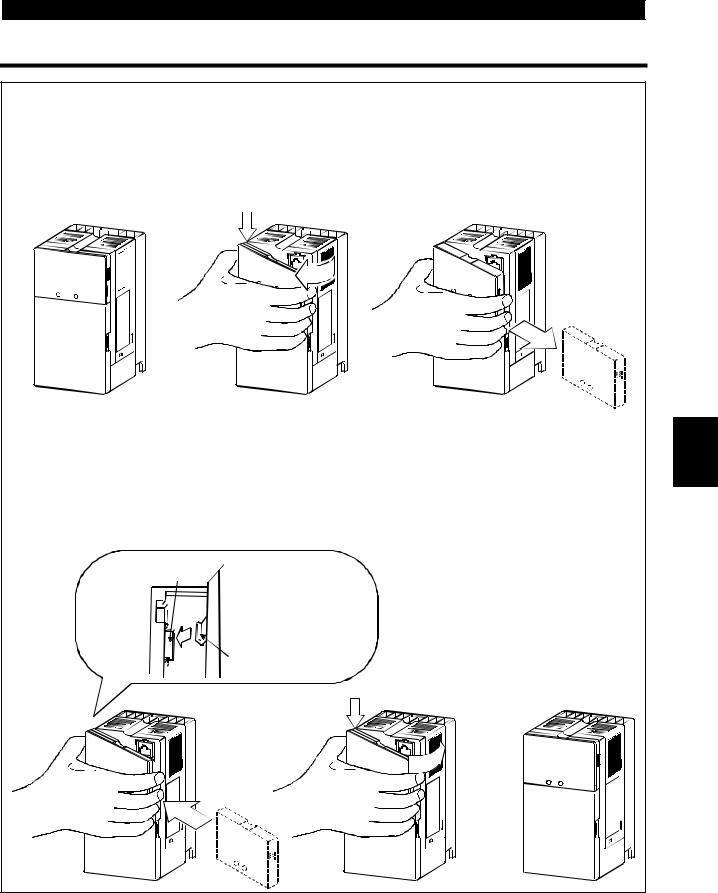
OUTLINE
1.3.4 Removal and reinstallation of the accessory cover
" Removal of the accessory cover
Hold down the portion A indicated by the arrow and lift the right hand side using the portion B indicated by the arrow as a support, and pull out the accessory cover to the right.
1) |
2) |
B |
3) |
|
 A
A
" Reinstallation of the accessory cover |
1 |
Insert the mounting catch (left hand side) of the accessory cover into the mounting position of the inverter and push in the right hand side mounting catch to install the accessory cover.
|
Mounting position |
|
|
|
||
|
|
Accessory cover |
|
|||
|
|
|
|
|
||
|
|
Catch |
|
|
|
|
1) |
2) |
A |
3) |
|||
|
||||||
|
|
|
|
|
|
|
8
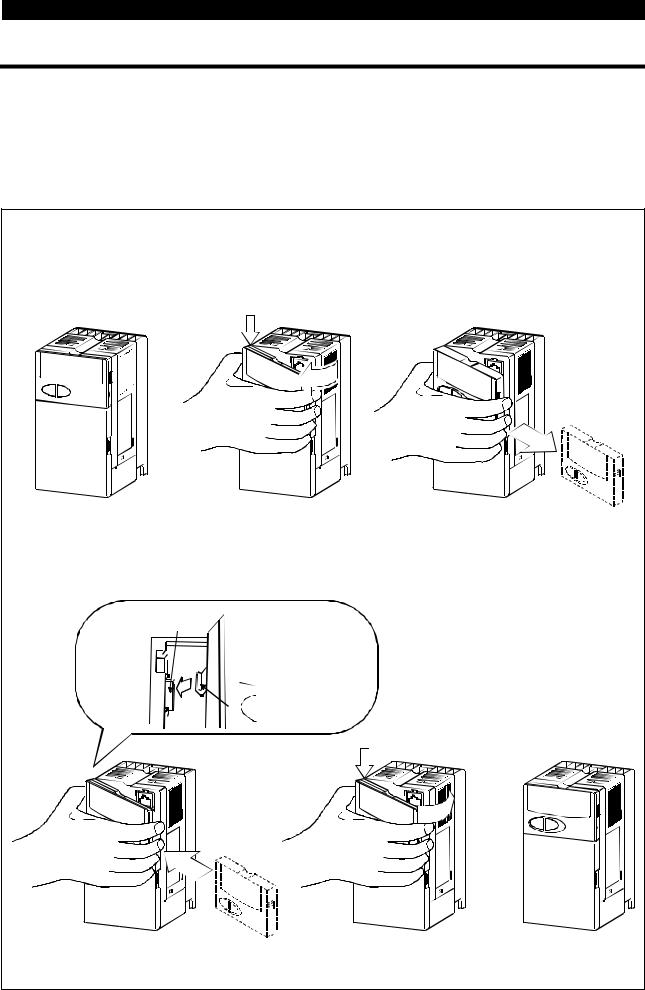
OUTLINE
1.3.5 Reinstallation and removal of the control panel
To ensure safety, reinstall and removal the optional control panel (FR-PA02-02) after switching power off.
The charging area and control printed board are exposed on the rear surface of the control panel. When removing the control panel, always fit the rear cover option FR-E5P. Never touch the control printed board because touching it can cause the inverter to fail.
" Reinstallation of the control panel
Insert the mounting catch (left hand side) of the control panel into the mounting position of the inverter and push in the right hand side mounting catch to install the control panel.
1) |
2) |
B |
3) |
|


 A
A
" Removal of the control panel
Hold down the portion A indicated by the arrow and lift the right hand side using the portion B indicated by the arrow as a support, and pull out the control panel to the right.
|
Mounting position |
|
|
||||
|
|
|
|
FR-PA02-02 |
|
||
|
|
|
|
|
|
|
|
|
|
|
|
||||
|
|
Catch |
|
|
|||
1) |
2) |
A |
|||||
3) |
|||||||
|
|
|
|
|
|
||
(If the above procedure is not used for removal, the internal connector may be damaged by the force applied.)
9
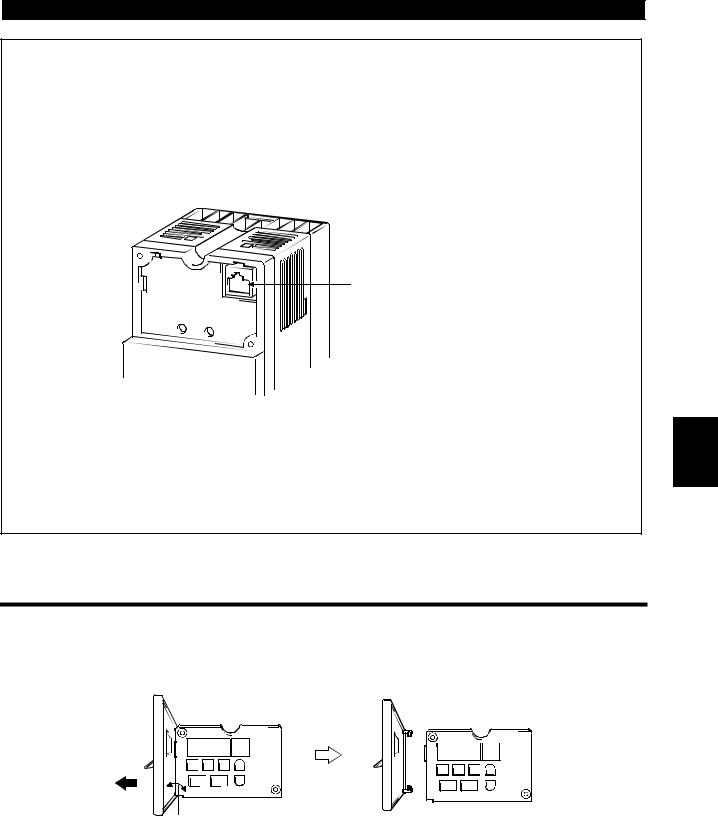
OUTLINE
"Using the connection cable for operation
1)Fit the rear cover option FR-E5P to the back surface of the optional control panel.
2)Securely plug one end of the connection cable into the PU connector of the inverter and the other end into the adaptor of the FR-E5P option to connect it to the control panel. (For the connection cable of the FR-E5P, refer to page 27.)
PU connector
(RS-485 cable specifications)
" Mounting the control panel on an enclosure
When you open the control panel front cover, the screw mounting guides for
fixing the control panel to an enclosure appear on the top left and bottom right. 1 Fit the rear cover of the FR-E5P option, drill holes in the control panel mounting
guides, and securely mount the control panel on the enclosure with screws.
1.3.6 Removal of the control panel (FR-PA02-02) front cover
1)Open the control panel front cover to 90 degrees.
2)Pull out the control panel front cover to the left to remove it.
90 degrees
10
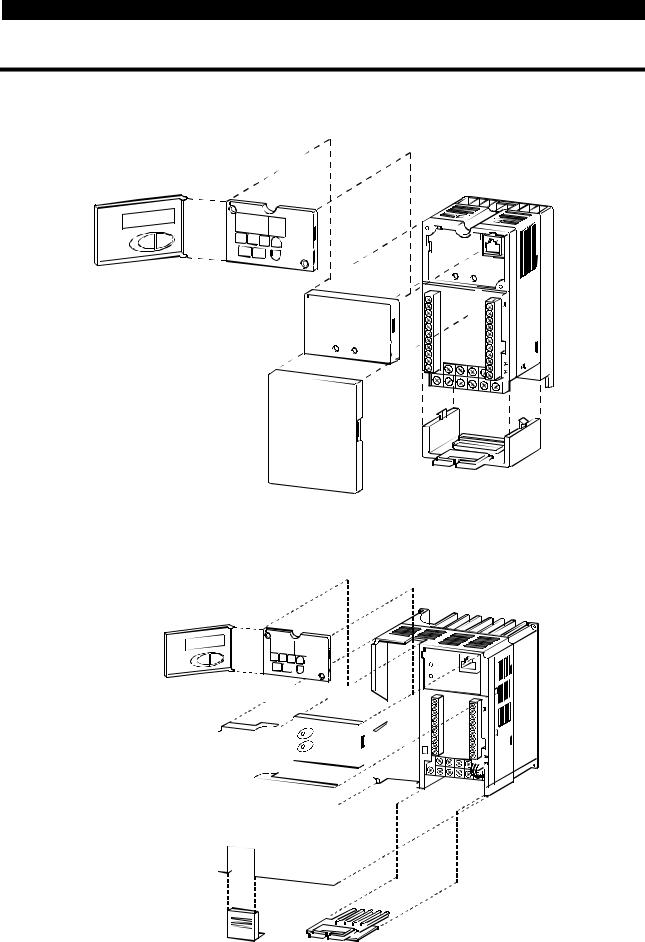
OUTLINE
1.3.7 Exploded view
"FR-E520-0.1K to 7.5K-NA
"FR-E510W-0.1K to 0.75K-NA
Control panel (FR-PA02 -02 )
Accessory cover
Wiring cover
Front cover
" FR-E540-0.4K to 7.5K-NA
Control panel (FR-PA02-02) 




|
|
|
|
|
|
|
|
|
|
|
|
|
|
|
|
|
|
|
|
|
|
|
|
|
|
|
|
|
|
|
|
|
|
|
|
|
|
|
|
|
|
|
|
|
|
|
|
|
|
|
|
|
|
|
|
|
|
|
|
|
|
|
|
Front cover |
|
|
|
Accessory |
|
|
|
|
|
|
|||||
|
|
|
|
||||||||||||
|
|
|
cover |
|
|
|
|
|
|
|
|
|
|
||
|
|
|
|
|
|
|
|
|
|
|
|
|
|||
|
|
|
|
|
|
|
|
|
|
|
|
|
|
||
|
|
|
|
|
|
|
|
|
|
|
|
|
|
|
|
|
|
|
|
|
|
|
|
|
|
|
|
|
|
|
|
|
|
|
|
|
|
|
|
|
|
|
|
|
|
|
|
|
|
|
|
|
|
|
|
|
|
|
|
|
|
|
|
Wiring port cover for option
Wiring cover
11
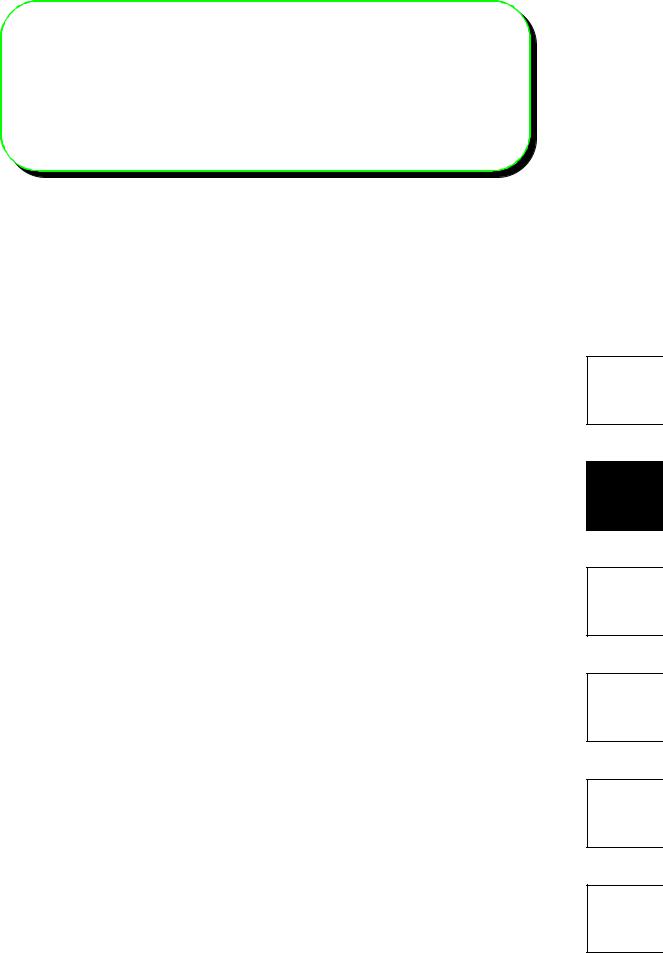
C CHAPTERA P T E R 2 2
IINSTALLATIONAND
WIIRIINNG
This chapter gives information on the basic "installation and wiring" for use of this product.
Always read the instructions in this chapter before using the equipment.
2.1 |
Installation .................................................................... |
12 |
2.2 |
Wiring ........................................................................... |
14 |
2.3 |
Other Wiring ................................................................. |
34 |
Chapter 1
Chapter 2
Chapter 3
Chapter 4
Chapter 5
Chapter 6
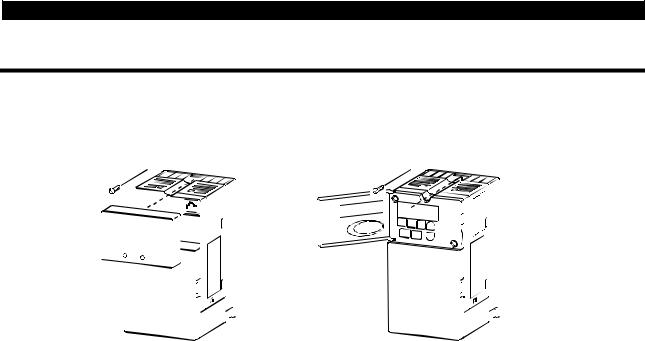
2.1 Installation
INSTALLATION AND WIRING
2.1.1 Instructions for installation
For the FR-E520-0.1K to 0.75K-NA and FR-E510W-0.1K to 0.4K-NA, install the inverter with the accessory cover or control panel (FR-PA02-02) front cover open.
<For the accessory cover> |
<For the control panel (FR-PA02-02 )> |
||||||||||||||||||||||||||||||||||||||||||||
|
|
|
|
|
|
|
|
|
|
|
|
|
|
|
|
|
|
|
|
|
|
|
|
|
|
|
|
|
|
|
|
|
|
|
|
|
|
|
|
|
|
|
|
|
|
|
|
|
|
|
|
|
|
|
|
|
|
|
|
|
|
|
|
|
|
|
|
|
|
|
|
|
|
|
|
|
|
|
|
|
|
|
|
|
|
|
|
|
|
|
|
|
|
|
|
|
|
|
|
|
|
|
|
|
|
|
|
|
|
|
|
|
|
|
|
|
|
|
|
|
|
|
|
|
|
|
|
|
|
|
|
|
|
|
|
|
|
|
|
|
|
|
|
|
|
|
|
|
|
|
|
|
|
|
|
|
|
|
|
|
|
|
|
|
|
|
|
|
|
|
|
|
|
|
|
|
|
|
|
|
|
|
|
|
|
|
|
|
|
|
|
|
|
|
|
|
|
|
|
|
|
|
|
|
|
|
|
|
|
|
|
|
|
|
|
|
|
|
|
|
|
|
|
|
|
|
|
|
|
|
|
|
|
|
|
|
|
|
|
|
|
|
|
|
|
|
|
|
|
|
|
|
|
|
|
|
|
|
|
|
|
|
|
|
|
|
|
|
|
|
|
|
|
|
|
|
|
|
|
|
|
|
|
|
|
|
|
|
|
|
|
|
|
|
|
|
|
|
|
|
|
|
|
|
|
|
|
|
|
|
|
|
|
|
|
|
|
|
|
|
|
|
|
|
|
|
|
|
|
|
|
|
|
|
|
|
|
|
|
|
|
|
|
|
|
|
|
|
|
|
|
|
|
|
|
|
|
|
|
|
|
|
|
|
|
|
|
|
|
|
|
|
|
|
|
|
|
|
|
|
|
|
|
|
|
|
|
|
|
|
|
|
|
|
|
|
|
|
|
|
|
|
|
|
|
|
|
|
|
|
|
|
|
|
|
|
|
|
|
|
|
|
|
|
|
|
|
|
|
|
|
|
|
|
|
|
|
|
|
|
|
|
|
|
|
|
|
|
|
|
|
|
|
|
|
|
|
|
|
|
|
|
|
|
|
|
|
|
|
|
|
|
|
|
|
|
|
|
|
|
|
|
|
|
|
|
|
|
|
|
|
|
|
|
|
|
|
|
|
|
|
|
|
|
|
|
|
|
|
|
|
|
|
|
|
|
|
|
|
|
|
|
|
|
|
|
|
|
|
|
|
|
|
|
|
|
|
|
|
|
|
|
|
|
|
|
|
|
|
|
|
|
|
|
|
|
|
|
|
|
|
|
|
|
|
|
|
|
|
|
|
|
|
|
|
|
|
|
|
|
|
|
|
|
|
|
|
|
|
|
|
|
|
|
|
|
|
|
|
|
|
|
|
|
|
|
|
|
|
|
|
|
|
|
|
|
|
|
|
|
|
|
|
|
|
|
|
|
|
|
|
|
|
|
|
|
|
|
|
|
|
|
|
|
|
|
|
|
|
|
|
|
|
|
|
|
|
|
|
|
|
|
|
|
|
|
|
|
|
|
|
|
|
|
|
|
|
|
|
|
|
|
|
|
|
|
|
|
|
1)Handle the unit carefully.
The inverter uses plastic parts. Handle it gently to protect it from damage.
Also, hold the unit with even strength and do not apply too much strength to the front cover alone.
2)Install the inverter in a place where it is not affected by vibration easily (5.9m/s2 maximum).
Note the vibration of a cart, press, etc.
3)Note on ambient temperature.
The inverter life is under great influence of ambient temperature. In the place of installation, the ambient temperature must be within the permissible range -10° C to
+50° C (14° F to 122° F). Check that the ambient temperature is within that range in the positions shown in figure 3).
4)Install the inverter on a non-combustible surface.
The inverter will be very hot (maximum about 150° C (302° F)). Install it on a noncombustible surface (e.g. metal). Also leave sufficient clearances around the inverter.
5)Avoid high temperatures and high humidity.
Avoid direct sunlight and places of high temperature and high humidity.
6)Avoid places where the inverter is exposed to oil mist, flammable gases, fluff, dust, dirt etc.
Install the inverter in a clean place or inside a "totally enclosed" panel which does not accept any suspended matter.
12
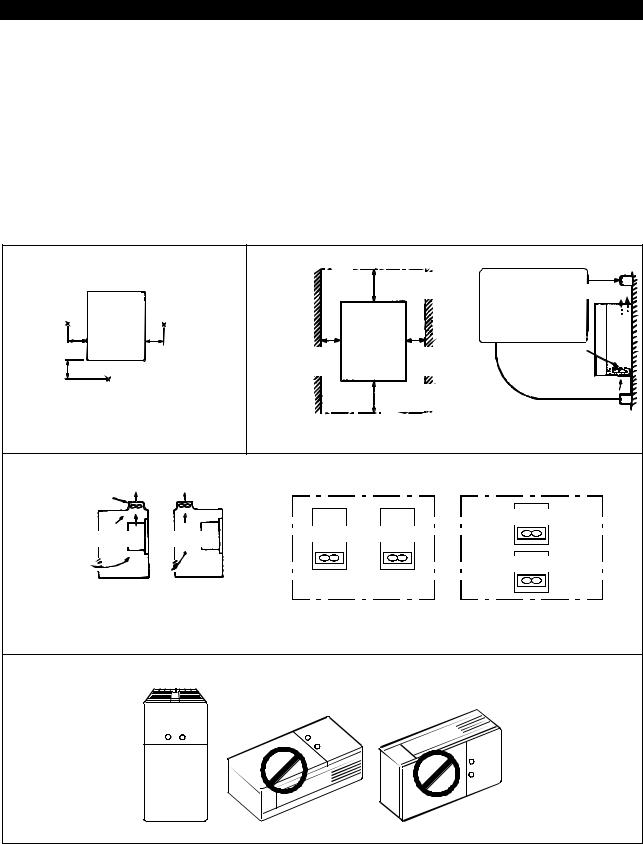
INSTALLATION AND WIRING
7)Note the cooling method when the inverter is installed in an enclosure.
When two or more inverters are installed or a ventilation fan is mounted in an enclosure, the inverters and ventilation fan must be installed in proper positions with extreme care taken to keep the ambient temperatures of the inverters with the permissible values. If they are installed in improper positions, the ambient temperatures of the inverters will rise and ventilation effect will be reduced.
8)Install the inverter securely in the vertical direction with screws or bolts.
3)Note on ambient temperatures
|
|
Measurement |
|
|
position |
5cm |
|
FR-E500 5cm |
(1.97inch) |
|
(1.97inch) |
5cm |
|
Measurement position |
(1.97inch) |
|
|
|
|
4) Clearances around the inverter
|
10cm (3.94inch) |
Leave sufficient |
|
|
or more |
clearances above Cooling air |
|
|
|
and under the |
|
|
|
inverter to ensure |
|
|
|
adequate ventilation. |
|
1cm (0.39inch) |
1cm (0.39inch) |
Cooling fan |
|
or more* |
FR-E500 or more* |
|
built in the |
|
10cm (3.94inch) |
|
inverter |
|
|
|
|
|
or more |
|
|
*5cm (1.97inch) or more for 5.5K and 7.5K
These clearances are also necessary for changing the cooling fan.
7) For installation in an enclosure |
|
|
|
|
|
Ventilation |
|
|
|
|
|
fan |
|
|
|
Inverter |
|
|
|
|
|
|
|
Inverter |
Inverter |
Inverter |
Inverter |
|
|
|
|
|
2 |
||
|
|
|
|
Inverter |
|
(Correct example) |
(Incorrect example) |
Built-in cooling fan |
|
|
|
|
|
|
|
||
Position of Ventilation Fan |
(Correct example) |
(Incorrect example) |
|
||
|
|
|
|||
|
|
When more than one inverter is contained |
|
||
8) Vertical mounting
13
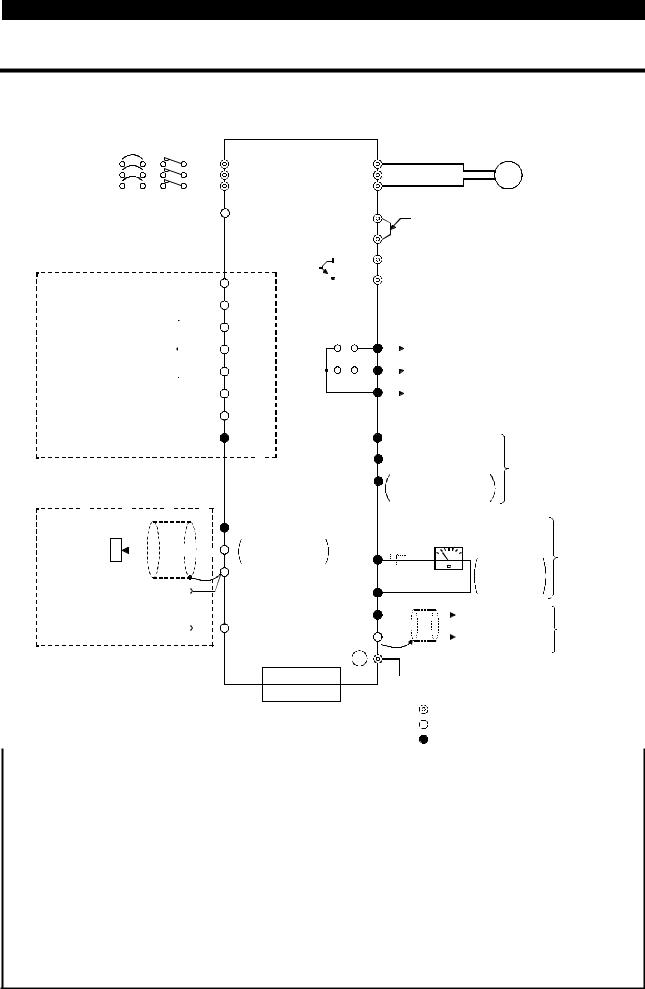
2.2 Wiring
INSTALLATION AND WIRING
2.2.1 Terminal connection diagram
"3-phase 200V power input
"3-phase 400V power input
3-phase |
|
|
|
NFB MC |
|
|
|
|
|
|
|
|
|
|
|
|
|
|
|
|
|
|
|
|
|
|
|
|
|
|
|
|
|
|
Motor |
|
|||||||||||||||||||
|
|
|
|
|
|
|
|
|
|
|
|
|
|
|
R(L1) |
|
|
|
|
|
|
|
U |
|
|
|
|
|
|
|
|
|
|
|
|||||||||||||||||||||
|
|
|
|
|
|
|
|
|
|
|
|
|
|
|
|
|
|
|
|
|
|
|
|
|
|
|
|
|
|
|
|
|
|||||||||||||||||||||||
AC power |
|
|
|
|
|
|
|
|
|
|
|
|
|
|
|
S(L2) |
|
|
|
|
|
|
|
|
V |
|
|
|
|
|
|
|
|
|
|
|
|
|
IM |
|
|||||||||||||||
|
|
|
|
|
|
|
|
|
|
|
|
|
|
|
|
|
|
|
|
|
|
|
|
|
|
|
|
|
|
|
|
|
|
|
|
|
|||||||||||||||||||
supply |
|
|
|
|
|
|
|
|
|
|
|
|
|
|
|
T(L3) |
|
|
|
|
|
|
W |
|
|
|
|
|
|
|
|
|
|
|
|
|
|
|
|
|
|
Ground |
|||||||||||||
|
|
|
|
|
|
|
|
|
|
|
|
|
|
|
|
|
|
|
|
|
|
|
|
|
|
|
|
|
|
|
|
|
|||||||||||||||||||||||
|
|
|
|
|
|
|
|
|
|
|
|
|
|
|
|
|
|
|
|
|
|
|
|
|
|
|
|
|
|
|
|
|
|||||||||||||||||||||||
24VDC power output and |
PC |
|
|
|
|
|
|
|
|
|
|
|
|
|
|
|
|
|
|
|
|
|
|
|
|
|
|
|
|
|
|
|
|||||||||||||||||||||||
|
|
|
|
|
|
|
|
|
|
|
|
|
|
|
|
|
|
|
|
|
|
|
|
|
|
|
|
|
|
|
|||||||||||||||||||||||||
|
|
|
|
|
|
|
|
|
|
|
|
|
|
|
|
|
|
|
|
|
|
|
|
|
|
|
|
|
|
|
|||||||||||||||||||||||||
|
|
|
|
|
|
|
|
|
|
|
|
|
|
|
|
|
|
|
|
|
|
|
|
|
|
|
|
|
|
|
|
|
|||||||||||||||||||||||
external transistor common |
|
|
|
|
|
P1 |
|
|
|
|
|
|
Jumper |
|
|
|
|
|
|
|
|
|
|
|
|
||||||||||||||||||||||||||||||
|
|
|
|
|
|
|
|
|
|
|
|
|
|
|
|
Note 5 |
|
|
|
(+)P |
|
|
|
|
|
|
Remove this jumper when |
|
|||||||||||||||||||||||||||
|
|
|
|
|
|
|
|
|
|
|
|
|
|
|
|
|
|
|
|
|
|
|
|
|
|
|
|
|
|
|
|
|
|||||||||||||||||||||||
|
|
|
|
|
|
|
|
|
|
|
|
|
|
|
|
|
|
|
|
|
|
|
|
|
|
|
|
|
|
|
|
using the optional power-factor |
|||||||||||||||||||||||
|
|
|
|
|
|
|
|
|
|
|
|
|
|
|
|
|
|
|
|
|
|
|
|
|
|
|
PR |
|
|
|
|
|
|
||||||||||||||||||||||
|
|
|
|
|
|
|
|
|
|
|
|
|
|
|
|
|
|
|
|
|
|
|
|
|
|
|
|
|
|
|
|
|
improving DC reactor. |
|
|||||||||||||||||||||
|
|
|
|
|
|
|
|
|
|
|
|
|
|
|
|
|
|
|
|
|
|
|
|
|
|
|
|
|
|
|
|
|
|||||||||||||||||||||||
|
|
Forward rotation start |
STF |
|
|
|
|
|
|
(-)N |
|
|
|
|
|
|
Brake resistor connection |
|
|||||||||||||||||||||||||||||||||||||
|
|
|
|
|
|
|
|
|
|
|
|
|
|
|
|
||||||||||||||||||||||||||||||||||||||||
|
|
|
|
|
|
|
|
|
|
|
|
|
|
|
|
|
|
|
|
|
|
|
Note 2 |
|
|
|
|
|
|
|
|||||||||||||||||||||||||
|
|
Reverse rotation start |
STR |
|
|
|
|
|
|
|
|
|
|
|
|
|
|
|
|
|
|
|
|
||||||||||||||||||||||||||||||||
|
|
|
|
|
|
|
|
|
|
|
|
|
|
|
|
|
|
|
|
|
|
|
|
|
|
|
|
|
|
|
|
|
|
|
|||||||||||||||||||||
|
|
|
|
|
|
|
|
|
|
|
|
High |
RH |
|
|
|
|
|
|
A |
|
|
|
|
|
|
|
|
|
|
|
|
|
|
|
|
|
|
|
|
|
||||||||||||||
Multi-speed selection Middle |
|
|
|
|
|
|
|
|
|
|
|
|
|
|
|
|
|
|
|
|
|
|
|
|
|
|
|
|
|
|
|
|
|
||||||||||||||||||||||
RM |
|
|
|
|
|
|
|
|
|
|
|
|
|
|
|
|
|
|
|
|
|
|
|
|
|
|
|||||||||||||||||||||||||||||
|
|
|
|
|
|
B |
|
|
|
|
|
|
|
Alarm |
|
|
|
|
|
|
|
|
|
|
|
|
|||||||||||||||||||||||||||||
|
|
|
|
|
|
|
|
|
|
|
|
Low |
RL |
|
|
|
|
|
|
|
|
|
|
|
|
|
|
|
|
|
|
|
|
|
|
|
|
|
|
||||||||||||||||
|
|
|
|
|
|
|
|
|
|
|
|
|
|
|
|
|
|
|
|
|
C |
|
|
|
|
|
output |
|
|
|
|
|
|
|
|
|
|
|
|
||||||||||||||||
|
|
|
|
|
|
|
|
|
|
|
|
|
|
|
|
|
|
|
|
|
|
|
|
|
|
|
|
|
|
|
|
|
|
|
|
|
|
||||||||||||||||||
|
|
|
|
|
|
|
|
|
|
|
|
|
|
|
|
|
|
|
|
|
|
|
|
|
|
|
|
|
|
|
|
|
|
|
|
|
|
|
|
|
|
|
|
|
|
||||||||||
|
|
|
|
|
|
|
|
Output stop |
MRS |
|
|
|
|
|
|
|
|
|
|
|
|
|
|
|
|
|
|
|
|
|
|
|
|
|
|
||||||||||||||||||||
|
|
|
|
|
|
|
|
|
|
|
|
|
|
|
|
|
|
|
|
|
|
|
|
|
|
|
|
|
|
|
|
|
|
|
|
|
|
|
|
|
|||||||||||||||
|
|
|
|
|
|
|
|
|
|
|
Reset |
RES |
|
|
|
|
|
|
|
|
|
|
|
|
|
|
|
|
|
|
|
|
|
|
|
|
|
|
|
|
|
|
|
|
|
||||||||||
|
Contact input common |
SD |
|
|
|
|
|
|
|
RUN |
Running |
|
|
|
|
|
|
|
|
|
|
|
|
||||||||||||||||||||||||||||||||
|
|
|
|
|
|
|
|
|
|
|
|
|
|
|
|
|
|
||||||||||||||||||||||||||||||||||||||
|
|
|
|
|
|
|
|
|
|
|
|
|
|
|
|
Note 4 |
|
|
|
|
|
FU |
Frequency detection |
|
|
|
|
|
|
Open |
|
||||||||||||||||||||||||
Control input signals |
|
|
|
|
|
|
|
|
|
|
|
|
|
|
|
|
|
|
|||||||||||||||||||||||||||||||||||||
|
|
|
|
|
|
|
|
|
|
|
SE |
|
|
|
|
|
|
|
|
|
|
|
|
|
|
|
|
collector outputs |
|||||||||||||||||||||||||||
(no voltage input allowed) |
|
|
|
|
|
|
|
|
|
|
|
|
Open collector |
|
|
|
|
|
|
||||||||||||||||||||||||||||||||||||
|
|
|
|
|
|
|
|
|
|
|
|
|
|
|
|
|
|
|
|
|
|
||||||||||||||||||||||||||||||||||
Frequency setting signals (analog) |
|
|
|
|
|
|
|
Note 3 |
|
output common) |
|
|
|
|
|
|
|
|
|
|
|||||||||||||||||||||||||||||||||||
|
|
|
|
|
|
|
|
|
|
|
|
|
|
|
|
|
|
|
|
|
|
|
|
|
|
|
|
|
|
|
|
|
|
|
|
|
|
|
|
||||||||||||||||
|
3 |
|
|
|
|
|
|
|
|
|
|
|
|
10(+5V) |
|
|
|
|
|
|
|
|
|
|
|
|
|
|
|
|
|
|
|
|
|
Meter |
|
|
|
|
|
|
|
|
|
For 200V |
|||||||||
(Note 1) |
|
2 |
|
|
|
|
|
|
|
|
|
|
|
|
|
|
|
|
|
|
|
|
|
|
|
|
|
|
|
(e.g. frequency meter) |
|||||||||||||||||||||||||
|
|
|
|
|
|
|
|
|
|
|
|
|
0 to 5VDC Selected |
|
|
|
|
|
|
|
|
|
|
|
|
|
|
|
|
|
|
||||||||||||||||||||||||
|
|
|
|
|
|
|
|
|
|
|
|
|
|
|
|
|
|
|
|
|
|
|
|
|
|
|
|
|
|
|
|
+ |
|
|
- |
|
|
|
|
|
|
|
|
|
and100V |
||||||||||
|
|
|
|
|
|
|
|
|
|
|
|
|
|
|
|
|
|
|
|
|
|
|
|
|
|
|
|
|
|
|
|
|
|
|
|
|
|
|
|
|
|
|
|
|
|
|
|||||||||
Frequency |
|
|
|
|
|
|
|
|
|
|
|
|
|
|
|
2 0 to 10VDC |
|
|
|
|
|
FM |
|
|
|
|
|
|
|
|
|
|
|
|
|
|
|||||||||||||||||||
setting |
1 |
|
|
|
|
|
|
|
|
|
|
|
|
5(Common) |
|
|
|
|
|
|
|
|
|
|
|
|
|
|
|
|
|
|
|
|
|
|
|
Moving-coil |
class |
||||||||||||||||
|
|
|
|
|
|
|
|
|
|
|
|
|
|
|
|
|
|
|
|
|
|
|
|
|
|
|
Calibration |
|
type1mA |
|
|||||||||||||||||||||||||
potentiometer |
|
|
|
|
|
|
|
|
|
|
|
|
|
|
|
inverters |
|||||||||||||||||||||||||||||||||||||||
Note 4 |
|
|
|
|
|
|
|
|
|
|
|
|
|
|
resistor (Note 6) |
|
|||||||||||||||||||||||||||||||||||||||
1/2W1kΩ Current input(-) |
|
|
|
|
|
SD |
|
|
|
|
|
|
|
|
|
full-scale |
|
||||||||||||||||||||||||||||||||||||||
|
|
|
|
|
|
|
|
|
|
|
|
|
|
|
|||||||||||||||||||||||||||||||||||||||||
|
|
|
|
|
|
|
|
|
|
|
|
|
|
|
|
|
|
|
|
|
|
|
Note 3 |
|
|
|
|
|
|
|
|
(+) Analog signal |
|
||||||||||||||||||||||
|
4 to 20mADC(+) |
|
|
|
|
4(4 to 20mADC) |
|
|
|
|
AM |
|
|
|
|
|
|
|
|
|
For 400V |
||||||||||||||||||||||||||||||||||
|
|
|
|
|
|
|
|
|
|
|
|
|
|
|
|
|
|
||||||||||||||||||||||||||||||||||||||
|
|
|
5 |
|
|
|
|
|
|
|
|
|
|
|
|
output |
class |
||||||||||||||||||||||||||||||||||||||
|
|
|
|
|
|
|
|
|
|
|
|
|
|||||||||||||||||||||||||||||||||||||||||||
|
|
|
|
|
|
|
|
|
|
|
|
|
|
|
|
|
|
|
|
|
|
|
|
|
|
|
|
|
|
|
|
|
|
(− ) (0 to 10VDC) |
inverter |
||||||||||||||||||||
|
|
|
|
|
|
|
|
|
|
|
|
|
|
|
|
|
|
|
|
|
|
|
|
|
|
|
|
|
|
|
|
|
|
||||||||||||||||||||||
|
|
|
|
|
|
|
|
|
|
|
|
|
|
|
|
|
|
|
|
|
|
|
|
|
|
|
|
|
|
|
|
|
|
|
|
|
|
|
|
|
|
|
|
||||||||||||
|
|
|
|
|
|
|
|
|
|
|
|
|
|
|
|
|
|
|
|
|
|
|
|
|
|
|
|
|
|
|
|
|
|
|
|
|
|
|
|
|
Ground |
|
|
|
|
|
|
|
|
|
|
|
|
||
|
|
|
|
|
|
|
|
|
|
|
|
|
|
|
|
|
|
|
|
|
|
|
|
|
|
|
|
|
|
|
|
|
|
|
|
|
|
|
|
|
|
|
|
|
|
|
|
|
|
|
|
|
|||
|
|
|
|
|
|
|
|
|
|
|
|
|
|
|
|
|
|
|
|
|
|
|
|
|
|
|
|
|
|
|
|
|
|
|
|
|
|
|
|
|
|
|
|
|
|
|
|
|
|
|
|
|
|||
|
|
|
|
|
|
|
|
|
|
|
|
|
|
|
|
|
|
PU connector |
|
|
|
|
|
|
|
|
|
|
|
|
|
|
|
|
|
|
|
|
|
|
|
|
|
|
|
|
|
|
|||||||
|
|
|
|
|
|
|
|
|
|
|
|
|
|
|
|
|
|
|
|
|
|
|
|
|
|
|
|
|
|
|
|
|
|
|
|
|
|
|
|
|
|
|
|
|
|
|
|
|
|
|
|||||
|
|
|
|
|
|
|
|
|
|
|
|
|
|
|
|
|
|
|
|
|
|
|
|
|
|
|
|
|
|
|
|
|
|
|
|
|
|
|
|
|
|
|
|
|
|
|
|
|
|||||||
|
|
|
|
|
|
|
|
|
|
|
|
|
|
|
|
|
|
(RS-485) |
|
|
|
|
|
|
|
|
|
|
|
|
|
|
|
|
|
|
|
|
|
|
|
|
|
|
|
|
|
|
|
|
|
||||
|
|
|
|
|
|
|
|
|
|
|
|
|
|
|
|
|
|
|
|
|
|
|
|
|
|
|
|
|
|
|
|
|
|
|
|
|
|
|
|
|
|
Main circuit terminal |
|
||||||||||||
|
|
|
|
|
|
|
|
|
|
|
|
|
|
|
|
|
|
|
|
|
|
|
|
|
|
|
|
|
|
|
|
|
|
|
|
|
|
|
|
|
|
|
|||||||||||||
|
|
|
|
|
|
|
|
|
|
|
|
|
|
|
|
|
|
|
|
|
|
|
|
|
|
|
|
|
|
|
|
|
|
|
|
|
|
|
|
|
|
Control circuit input terminal |
|||||||||||||
|
|
|
|
|
|
|
|
|
|
|
|
|
|
|
|
|
|
|
|
|
|
|
|
|
|
|
|
|
|
|
|
|
|
|
|
|
|
|
|
|
|
Control circuit output terminal |
|||||||||||||
|
|
|
|
|
|||||||||||||||||||||||||||||||||||||||||||||||||||
Note:1. If the potentiometer is to be operated often, use a 2W1kΩ |
|
|
|
potentiometer. |
|||||||||||||||||||||||||||||||||||||||||||||||||||
2.0.1K and 0.2K do not contain a transistor.
3.Terminals SD and SE are isolated.
4.Terminals SD and 5 are common terminals. Do not earth them to the ground. Terminals SD and 5 are not isolated. (Those of the 400V class are isolated.)
5.When terminals PC-SD are used as a 24VDC power supply, be careful not to short these terminals. If they are shorted, the inverter will be damaged.
6.Not needed when the control panel (FR-PA-02-02) or parameter unit (FRPU04) is used for calibration. Used when calibration must be made near the frequency meter for such a reason as a remote frequency meter. However, the frequency meter needle may not deflect to full-scale if the calibration resistor is connected. In this case, use this resistor and the control panel or parameter unit together.
14
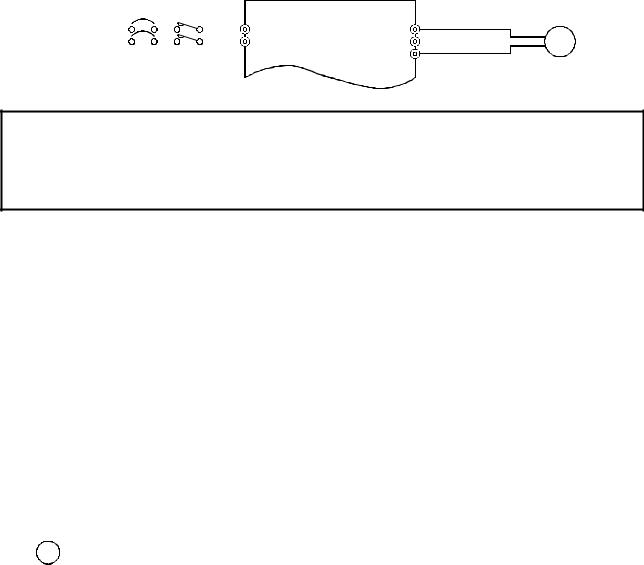
|
|
|
|
|
|
|
|
|
|
INSTALLATION AND WIRING |
|||||||||
" Single-phase 100V power input |
|
|
|
|
|
|
|
|
|
|
|||||||||
|
NFB MC |
|
Motor |
||||||||||||||||
Power supply |
|
|
|
|
|
|
|
|
R (L1) |
U |
|||||||||
|
|
|
|
|
|
|
|
||||||||||||
|
|
|
|
|
|
|
|
S (L2) |
V |
|
|
IM |
|||||||
|
|
|
|
|
|
|
|
|
|
|
|||||||||
|
|
|
|
|
|
|
|
|
|
W |
|
|
|
|
|
|
|
|
Ground |
|
|
|
|
|
|
|
|
|
|
|
|
|
|
|
|
|
|
||
|
|
|
|
|
|
|
|
|
|
|
|
|
|
|
|
|
|
|
|
|
|
|
|
|
|
|
|
|
|
|
|
|
|
|
|
|
|
|
|
|
|
|
|
|
|
|
|
|
|
|
|
|
|
|
|
|
|
|
|
Note:1. To ensure safety, connect the power input to the inverter via a magnetic contactor and earth leakage circuit breaker or no-fuse breaker, and use the magnetic contactor to switch power on-off.
2. The output is three-phase 200V.
(1) Description of the main circuit terminals
Symbol |
|
Terminal Name |
Description |
|
|
|||||||
R, S, T |
|
|
Connect to the commercial power supply. Keep these |
|
|
|||||||
(L1, L2, L3) |
|
AC power input |
terminals unconnected when using the high power factor |
|
|
|||||||
(Note) |
|
|
converter. |
|
|
|||||||
U, V, W |
|
Inverter output |
Connect a three-phase squirrel-cage motor. |
|
|
|||||||
P (+), PR |
|
Brake resistor |
Connect the optional brake resistor across terminals P-PR |
|
|
|||||||
|
connection |
(+ - PR) (not for 0.1K and 0.2K). |
|
|
||||||||
|
|
|
|
|
|
|
|
|
|
|
||
P (+), N (− |
) |
Brake unit |
Connect the optional brake unit or high power factor |
|
|
|||||||
connection |
converter. |
|
|
|||||||||
|
|
|
|
|
|
|
|
|
|
|
||
|
|
|
|
|
|
|
|
|
Power factor |
Disconnect the jumper from terminals P-P1 (+ - P1) and |
|
2 |
P (+), P1 |
|
improving DC |
|
|
||||||||
|
connect the optional power factor improving DC reactor. |
|
|
|||||||||
|
|
|
|
|
|
|
|
|
reactor connection |
|
|
|
|
|
|
|
|
|
|
|
|
|
|
||
|
|
|
|
|
|
|
|
|
Ground |
For grounding the inverter chassis. Must be earthed. |
|
|
|
|
|
|
|
|
|
|
|
|
|
||
|
|
|
|
|
|
|
|
|
|
|
||
|
|
|
|
|
|
|
|
|
|
|
|
|
|
|
|
|
|
|
|
|
|
|
|
|
|
Note: R, S (L1, L2) terminals for single-phase power input.
15

INSTALLATION AND WIRING
(2) Description of the control circuit terminals
Type |
Symbol |
Terminal |
|
Description |
|
|
||
Name |
|
|
|
|||||
|
|
|
|
|
|
|
||
|
|
|
Forward |
Turn on the STF signal to start forward |
When the STF |
|
||
|
|
STF |
and STR signals |
|
||||
|
|
rotation start |
rotation and turn it off to stop. |
are turned on |
|
|||
|
|
|
|
|||||
|
|
|
|
|
|
simultaneously, |
|
|
|
|
STR |
Reverse |
Turn on the STR signal to start reverse |
the stop |
|
||
|
etc |
rotation start |
rotation and turn it off to stop. |
command is |
|
|||
|
|
given. |
|
|||||
|
|
|
|
|
|
|||
|
(STOP) |
|
|
|
|
|
||
|
RH, RM, |
Multi-speed |
Combine the RH, RM and RL signals |
|
|
|||
|
as appropriate to select multiple |
|
|
|||||
|
RL |
selection |
Input terminal |
|
||||
|
speeds. |
|
|
|||||
|
|
|
|
function choices |
|
|||
|
start (STF), stop |
|
|
|
|
|||
|
|
|
Turn on the MRS signal (20ms or |
|
||||
Input signals |
|
|
(Pr. 180 to |
|||||
|
|
longer) to stop the inverter output. |
Pr. 183) change |
|||||
MRS |
Output stop |
Used to shut off the inverter output to |
||||||
terminal functions. |
||||||||
|
|
bring the motor to a stop by the |
|
|
||||
|
|
electromagnetic brake. |
|
|
||||
RES |
Reset |
Used to reset the protective circuit activated. Turn on the |
|
|||||
|
e.g. |
RES signal for more than 0.1 second then turn it off. |
|
|||||
|
|
|
|
|||||
|
|
Contact input |
Common to the contact input terminals and terminal FM. |
|
||||
|
Contacts, |
|
|
|||||
|
SD |
common |
Common output terminal for 24VDC 0.1A power output |
|
||||
|
|
(sink*) |
(PC terminal). |
|
|
|
||
|
|
Power output |
When transistor output (open collector output), such as a |
|
||||
|
|
and external |
|
|||||
|
|
|
programmable controller (PLC), is connected, connect the |
|
||||
|
|
|
transistor |
|
||||
|
|
|
external power supply common for transistor output to this |
|
||||
|
|
PC |
common |
|
||||
|
|
terminal to prevent a fault caused by undesirable current. |
|
|||||
|
|
|
Contact input |
|
||||
|
|
|
This terminal |
can be used as a 24VDC, 0.1A power |
|
|||
|
|
|
common |
|
||||
|
|
|
output. |
|
|
|
||
|
|
|
(source*) |
|
|
|
||
|
|
|
|
|
|
|
||
|
|
|
Frequency |
|
|
|
|
|
|
|
10 |
setting power |
5VDC, permissible load current 10mA |
|
|
||
|
|
|
supply |
|
|
|
|
|
|
|
|
|
By entering 0 to 5VDC (0 to 10VDC), the maximum output |
|
|||
|
Frequency setting |
|
Frequency |
frequency is reached at 5V (or 10V) and I/O are |
|
|||
|
2 |
setting |
proportional. Use Pr. 73 to switch between input 0 to |
|
||||
Analog |
|
(voltage) |
5VDC (factory setting) and 0 to 10VDC. Input resistance |
|
||||
|
|
10kΩ . Maximum permissible voltage 20V. |
|
|||||
|
|
|
|
|||||
|
Frequency |
By entering 4 to 20mADC, the maximum output frequency |
|
|||||
|
is reached at 20mA and I/O are proportional. This input |
|
||||||
4 |
setting |
|
||||||
signal is valid |
only when the AU signal is on. Input |
|
||||||
|
(current) |
|
||||||
|
|
|
|
|||||
|
|
|
resistance 250Ω |
. Maximum permissible current 30mA. |
|
|||
|
|
|
|
|
||||
|
|
|
Frequency |
Common to the frequency setting signals (terminal 2, 1 or 4). |
|
|||
|
|
5 |
setting input |
|
||||
|
|
Do not connect to the earth. |
|
|
||||
|
|
|
common |
|
|
|||
|
|
|
|
|
|
|
||
Note: Assign the AU signal to any of the terminals using the input terminal function selection (Pr. 180 to Pr. 183).
*Used as a contact input signal common terminal for the 400V class by switching between sink logic and source logic. (Refer to page 23).
16
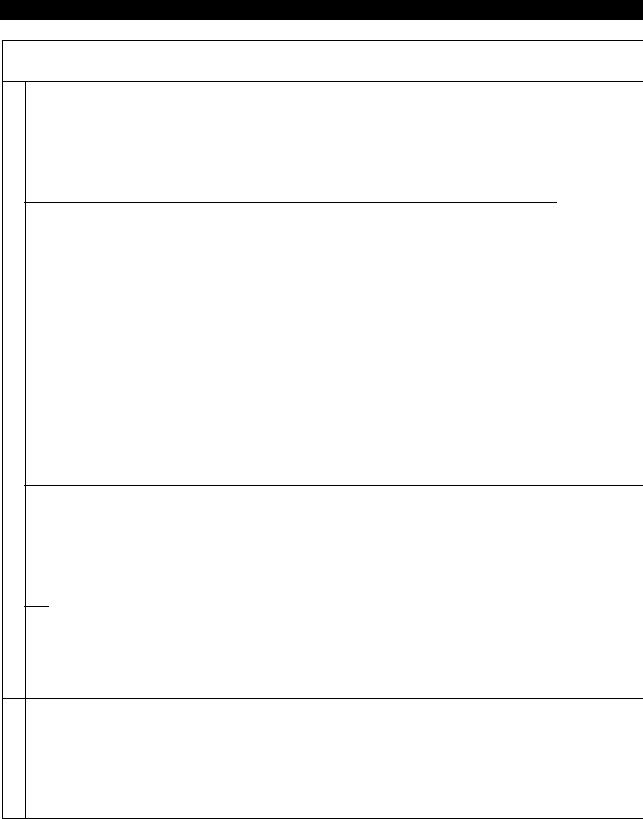
INSTALLATION AND WIRING
Type
Contact
Open collector
Output signals
Pulse
RS-485 Analog
Communication
Symbol |
Terminal |
Description |
|
|
|
||
Name |
|
|
|
||||
|
|
|
|
|
|
|
|
|
|
Contact output indicating that the output has |
|
|
|
||
|
|
been stopped by the inverter protective |
|
|
|
||
A, B, C |
Alarm output |
function activated. 230VAC 0.3A, 30VDC |
|
|
|
||
0.3A. Alarm: discontinuity across B-C |
|
|
|
||||
|
|
|
|
|
|||
|
|
(continuity across A-C), normal: continuity |
Output |
|
|
||
|
|
across B-C (discontinuity across A-C). |
terminal |
|
|
||
|
|
Switched low when the inverter output |
function |
|
|
||
|
|
frequency is equal to or higher than the |
choices |
|
|
||
RUN |
Inverter |
starting frequency (factory set to 0.5Hz, |
(Pr. 190 to |
|
|
||
running |
variable). Switched high during stop or DC |
Pr. 192) |
|
|
|||
|
|
|
|||||
|
|
injection brake operation (*1). |
change |
|
|
||
|
|
Permissible load 24VDC 0.1A. |
terminal |
|
|
||
|
|
Switched low when the output frequency has |
functions. |
|
|
||
|
Frequency |
reached or exceeded the detection frequency |
|
|
|
||
FU |
set as appropriate. Switched high when below |
|
|
|
|||
detection |
|
|
|
||||
|
the detection frequency (*1). |
|
|
|
|||
|
|
|
|
|
|||
|
|
Permissible load 24VDC 0.1A |
|
|
|
||
|
Open collector |
|
|
|
|
|
|
SE |
output |
Common to the RUN and FU terminals. |
|
|
|
||
|
common |
|
|
|
|
|
|
FM |
|
|
|
|
|
|
|
(200V |
|
One selected from output |
|
Factory setting of output item: |
|
|
|
and |
For meter |
|
Frequency |
|
|
|
|
100V |
frequency, motor current |
|
Permissible load current 1mA |
|
2 |
||
|
|
|
|||||
|
and output voltage is |
|
|
||||
class |
|
|
1440 pulses/s at 60Hz |
|
|
||
inverters) |
|
output (*2). The output |
|
|
|
|
|
|
|
|
|
|
|
||
|
|
signal is proportional to |
|
|
|
|
|
AM |
|
|
Factory setting of output item: |
|
|
||
|
the magnitude of each |
|
|
|
|||
(400V |
Analog signal |
|
Frequency |
|
|
|
|
monitoring item. |
|
|
|
|
|||
class |
output |
|
Output signal 0 to 10 VDC |
|
|
||
|
|
|
|
||||
only) |
|
|
|
Permissible load current 1mA |
|
|
|
|
|
|
|
|
|
||
|
|
With the control panel connector, communication can be |
|
|
|||
|
|
made using the RS-485 protocol. |
|
|
|
||
|
PU connector |
! Conforming Standard |
: EIA Standard RS-485 |
|
|
||
! Transmission format |
: Multi-drop link |
|
|
|
|||
|
|
|
|
|
|||
|
|
! Communication speed : Maximum 19200 bps |
|
|
|||
|
|
! Overall length |
: 500m (1640.40 feet) |
|
|
||
*1: Low indicates that the open collector output transistor is on (conducts). High indicates that the transistor is off (does not conduct).
*2: Not output during inverter resetting.
17
